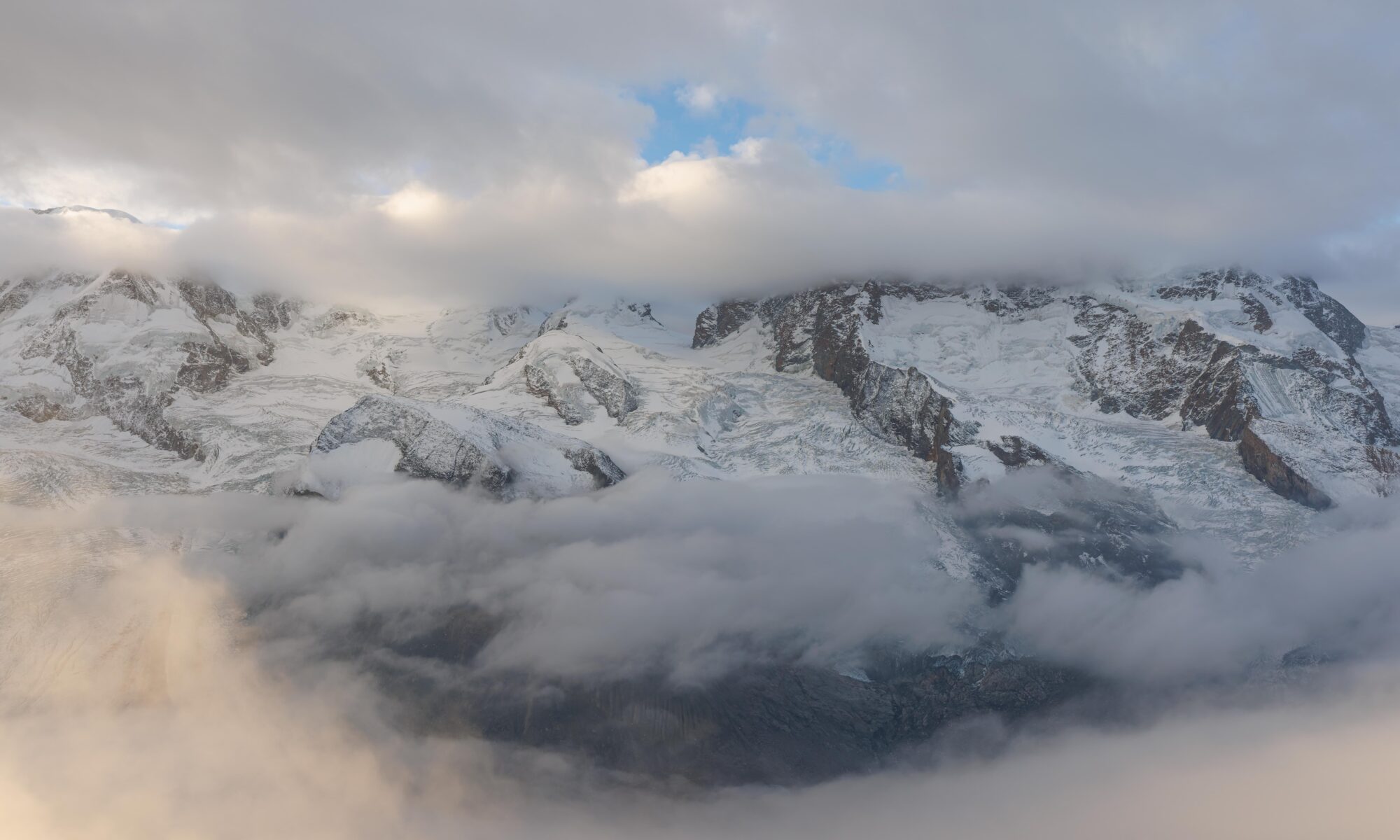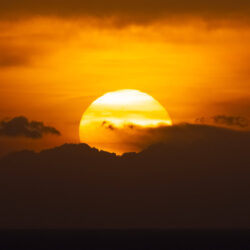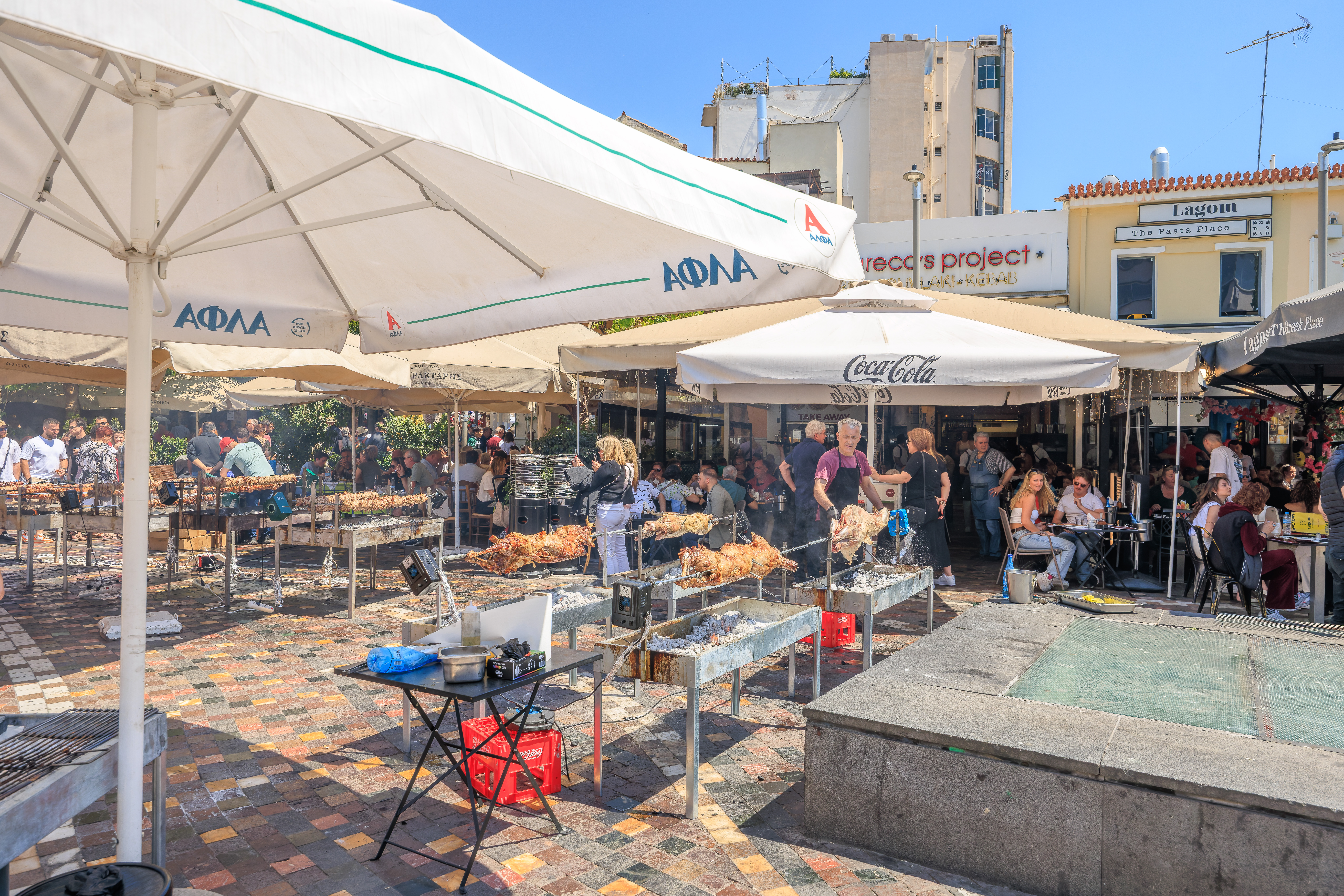Today is Easter Sunday! Most things are closed, including museums and historic sites. So, after breakfast at the Grande Bretagne, we went to the beach near Piraeus to touch the Mediterranean for the first time. After walking around a bit, we returned and had roasted lamb, a traditional Easter meal in Greece, at The Greco’s Project.
Morning
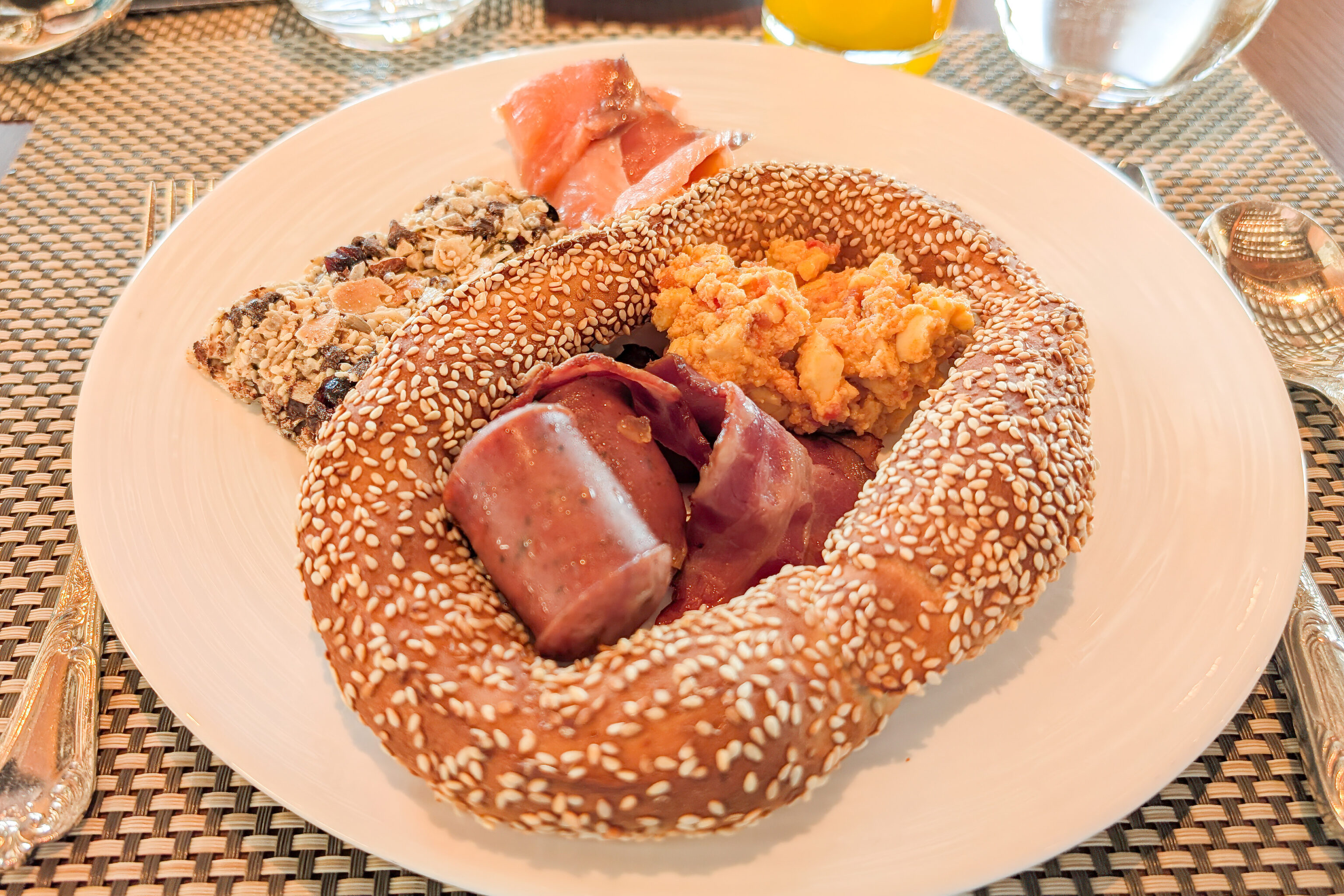
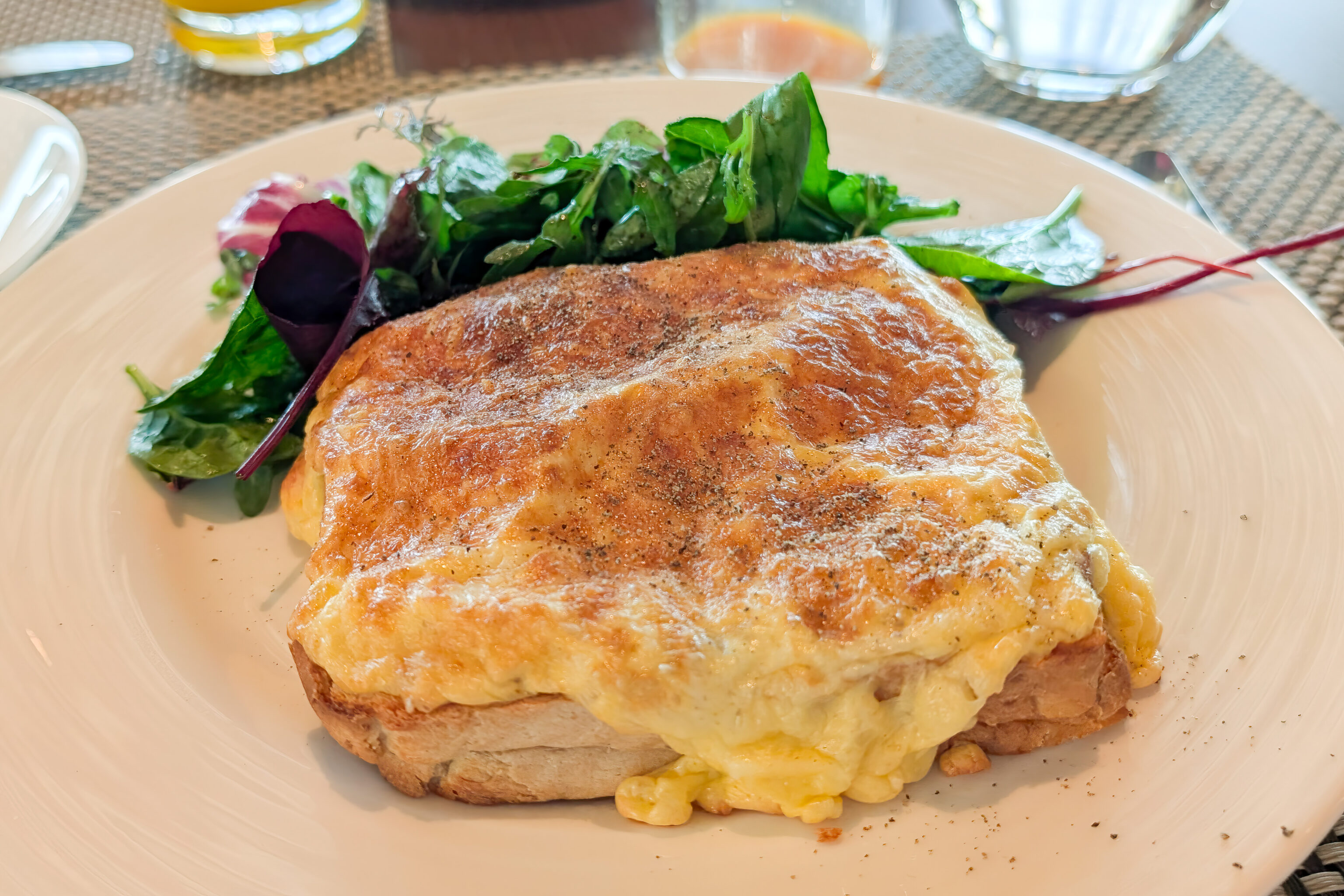

After waking up at the Grande Bretagne, we headed up to the GB Roof Garden for breakfast around 8:30am. That’s pretty late for us generally when traveling but just about everything is closed today as it is Easter Sunday.
The Greek Orthodox and Catholic churches have different ways of determining when Easter falls on the Gregorian Calendar. This year, they are on the same day, April 20th. For many Americans, today, 420, is a very different holiday.
We did get something new for breakfast today, or at least, it was new to us. We had a Croque Madame! It is similar to a Croque Monsieur but with an egg on top. Or, basically, a grilled cheese sandwich with an egg on top. It was pretty good!

Today is a Sunday. On Sundays, there is a larger guard change ceremony which takes place at the Monument to the Unknown Soldier at 11am. We’ve already seen the regular hourly guard change five times now! Its the same each time, there are always two guards and an officer here in front of the Old Royal Palace. Every hour, the replacement guard arrives consisting of two guards and an officer. There is some marching around and then the old guard leaves and new guard takes their place.
The larger Sunday ceremony includes the entire guard unit as well as a marching band. There were already many people here when we arrived at around 10:20am. We decided to stand on the left in the shade. We weren’t sure exactly where all the guards would stand so we hoped we had a good place.
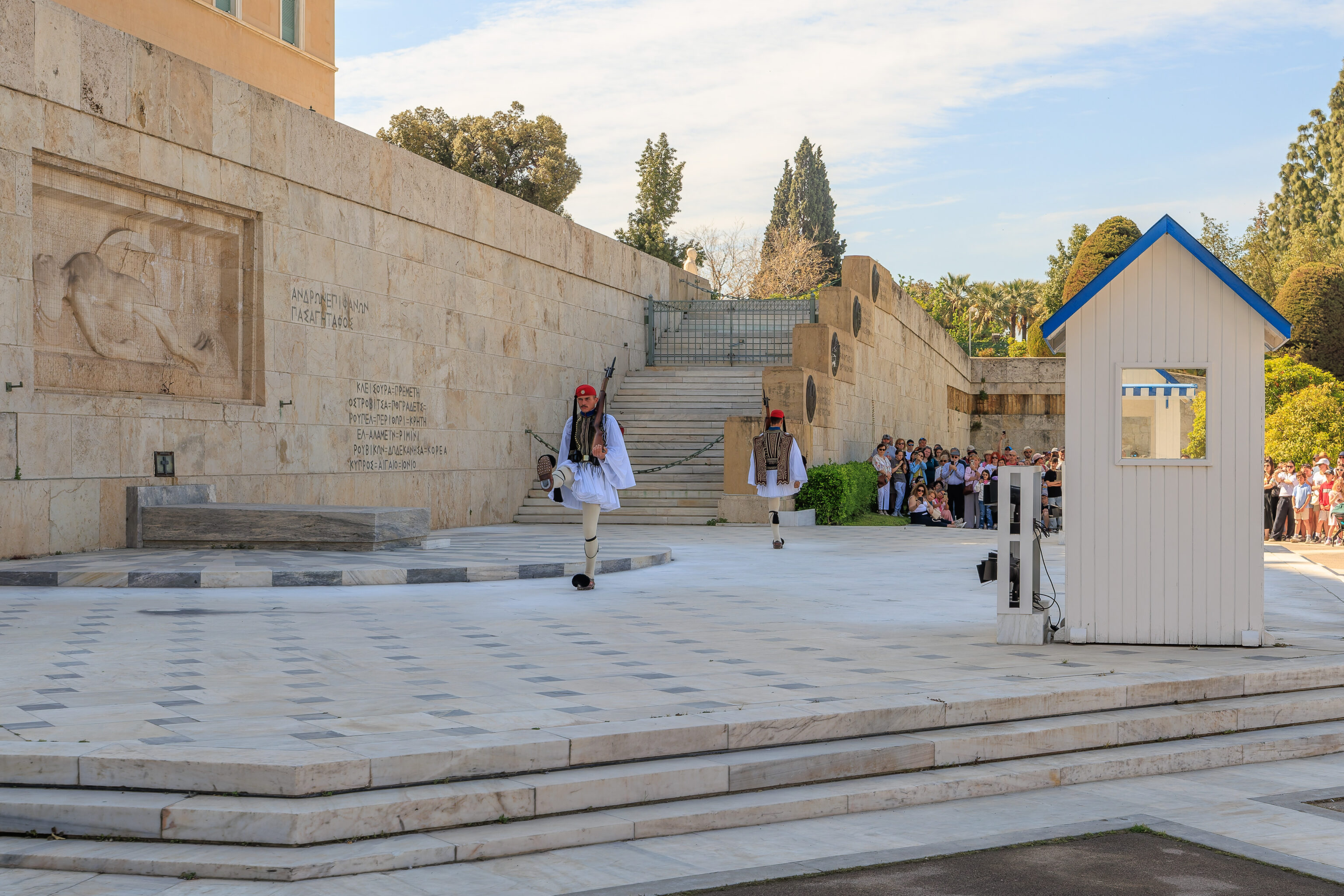
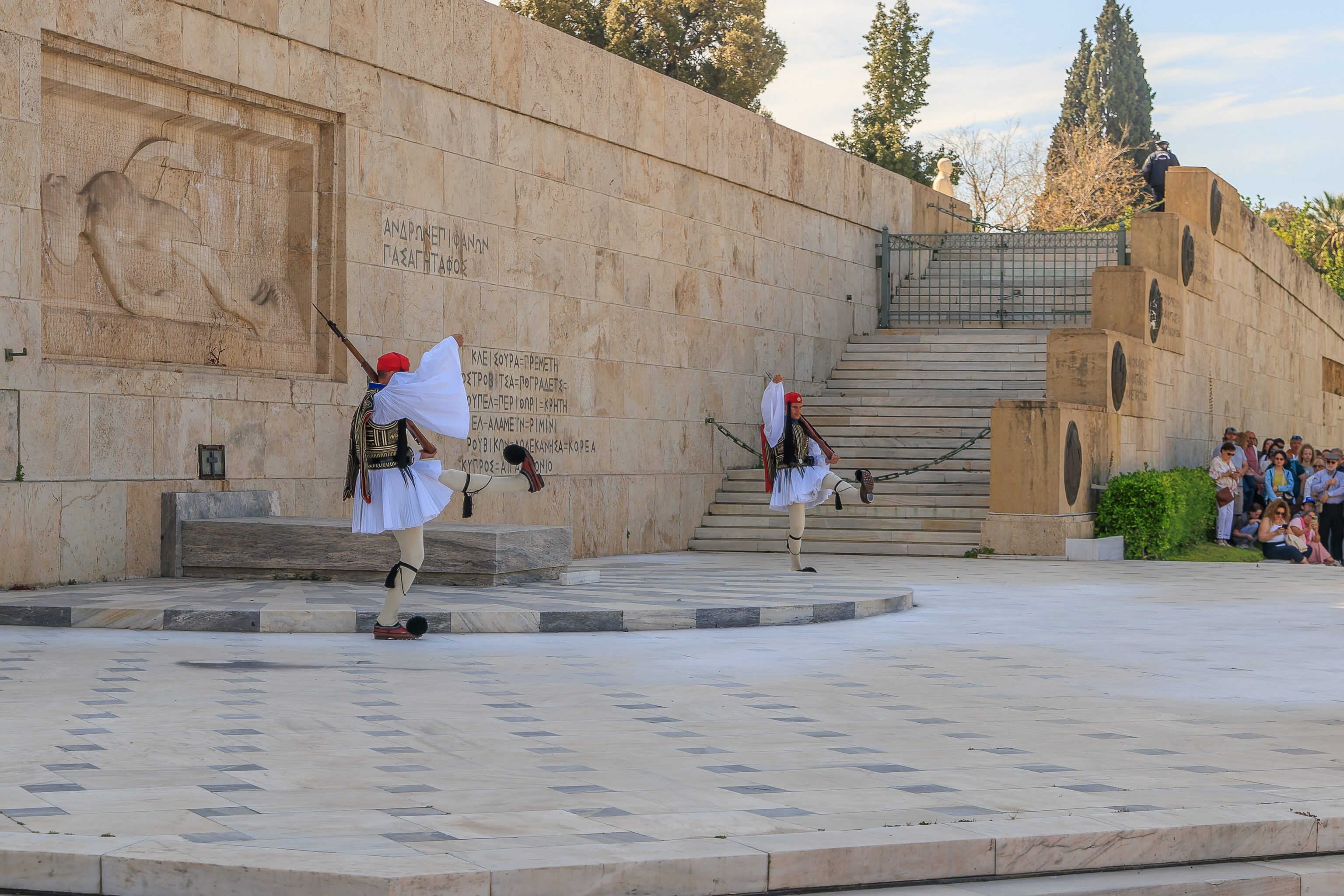
The guards move around periodically.
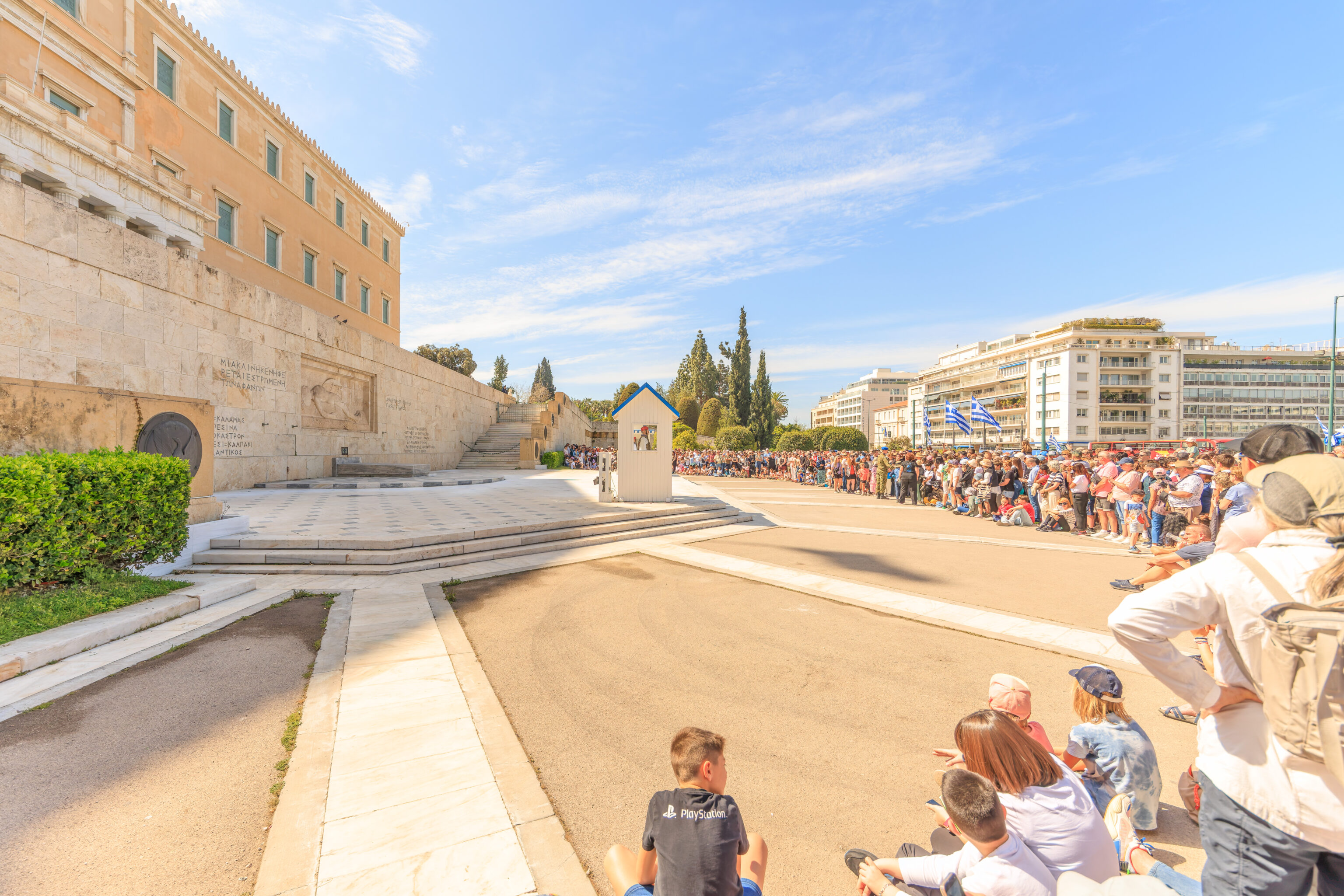
More and more people showed up as it got closer to 11am. It ended up being super crowded with people sitting on the ground and multiple rows of people behind us. We were lucky as we arrived early enough to have no one standing in front of us. The thing to do if arriving late seems to simply sit down on the ground in front of the crowd.
So, the guard change ended up being the same as it always is. There was some confusion as some people left and others like us waited around a bit. It turns out that the full guard change does not happen today as it is Easter Sunday! Well, at least we were able to make a good recording of the entire guard change, even if it was just the normal hourly one.
Palaio Faliro
We walked down into the Syntagma Metro station to catch a Metro to go see the Mediterranean. We decided to visit Palaio Faliro, a town to the east of the port city of Piraeus and southwest of Athens. To get there, we first took Line 3 (Blue) to Monastiraki.
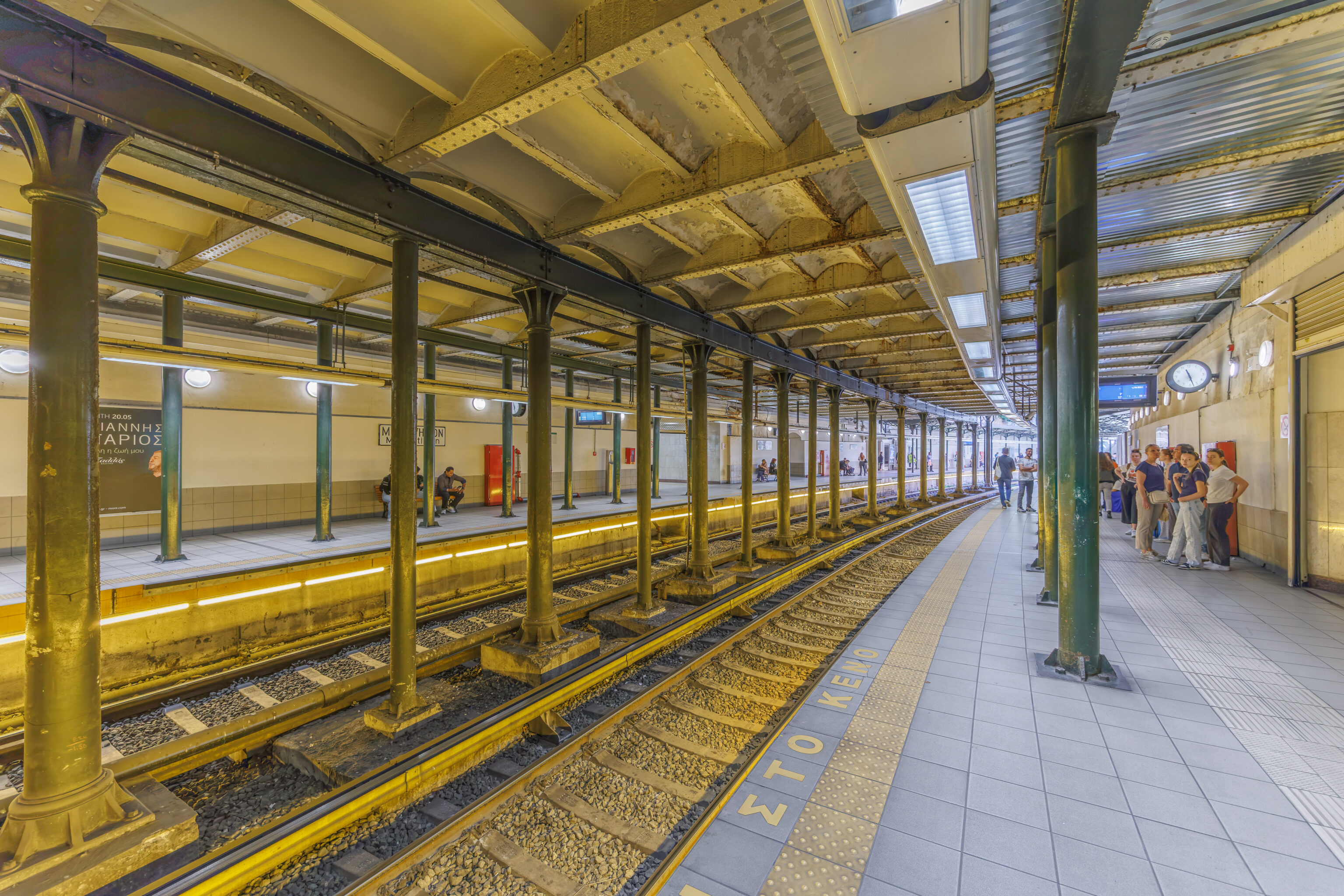
At Monastiraki, we switched to Line 1 (Green) and took it to Neo Faliro, which takes about 15 minutes.
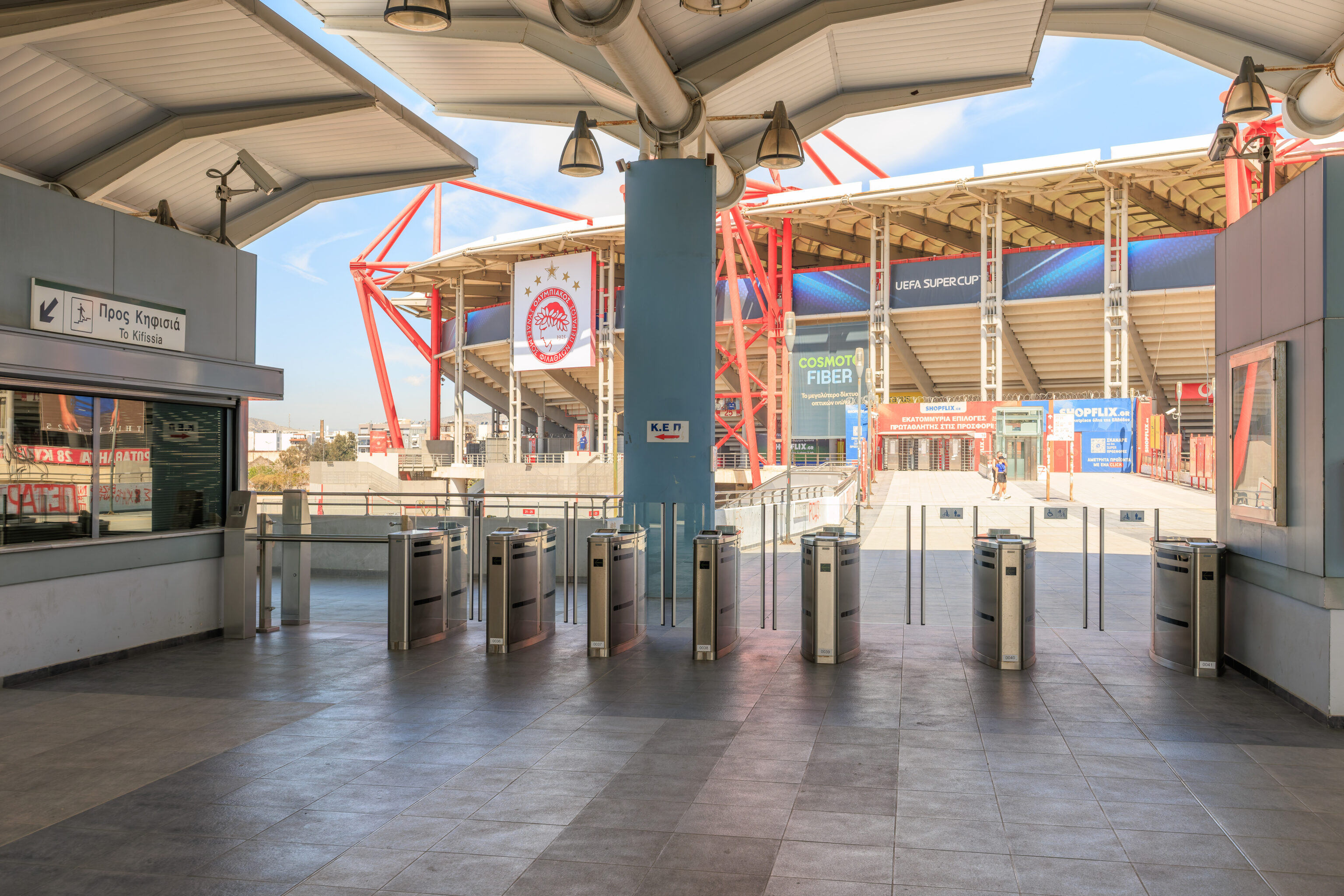
There is a football stadium, or as us Americans would say, a soccer stadium, on the north side of the station. Karaiskakis Stadium is home to the Olympiacos, a Piraeus football team.
Earlier on this trip, we went to the post office by Syntagma Square to buy stamps. It was busy and we had to take a number. While waiting, we noticed they had Olympics stamps. So, we were going to buy some. We realized while waiting that they were not for the Olympic Games but stamps for the Olympiacos football team! We ended up leaving without buying anything as the queue was basically not moving at all.
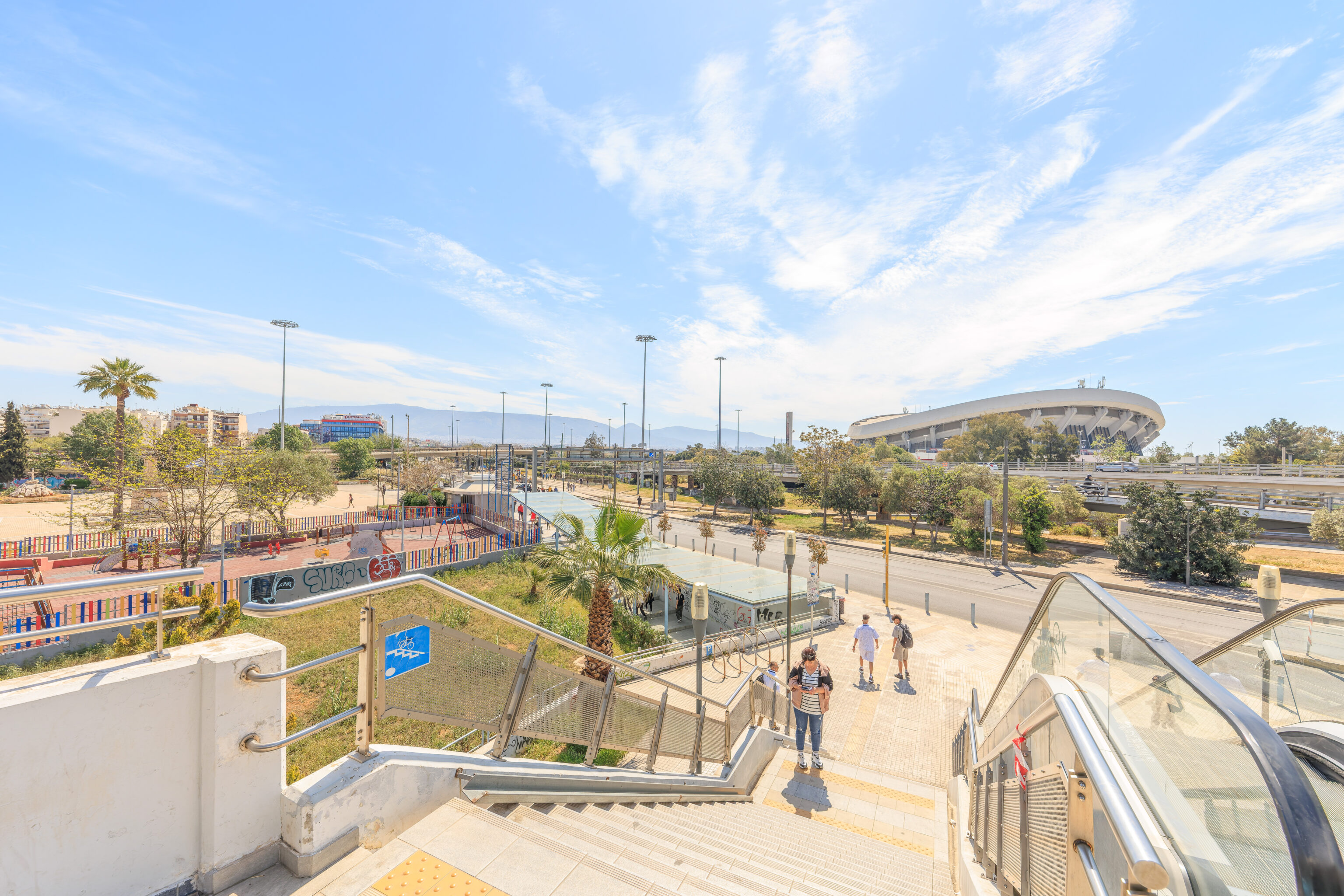
We exited the Metro station on the south side to take a tram. We had to descend down some stairs.
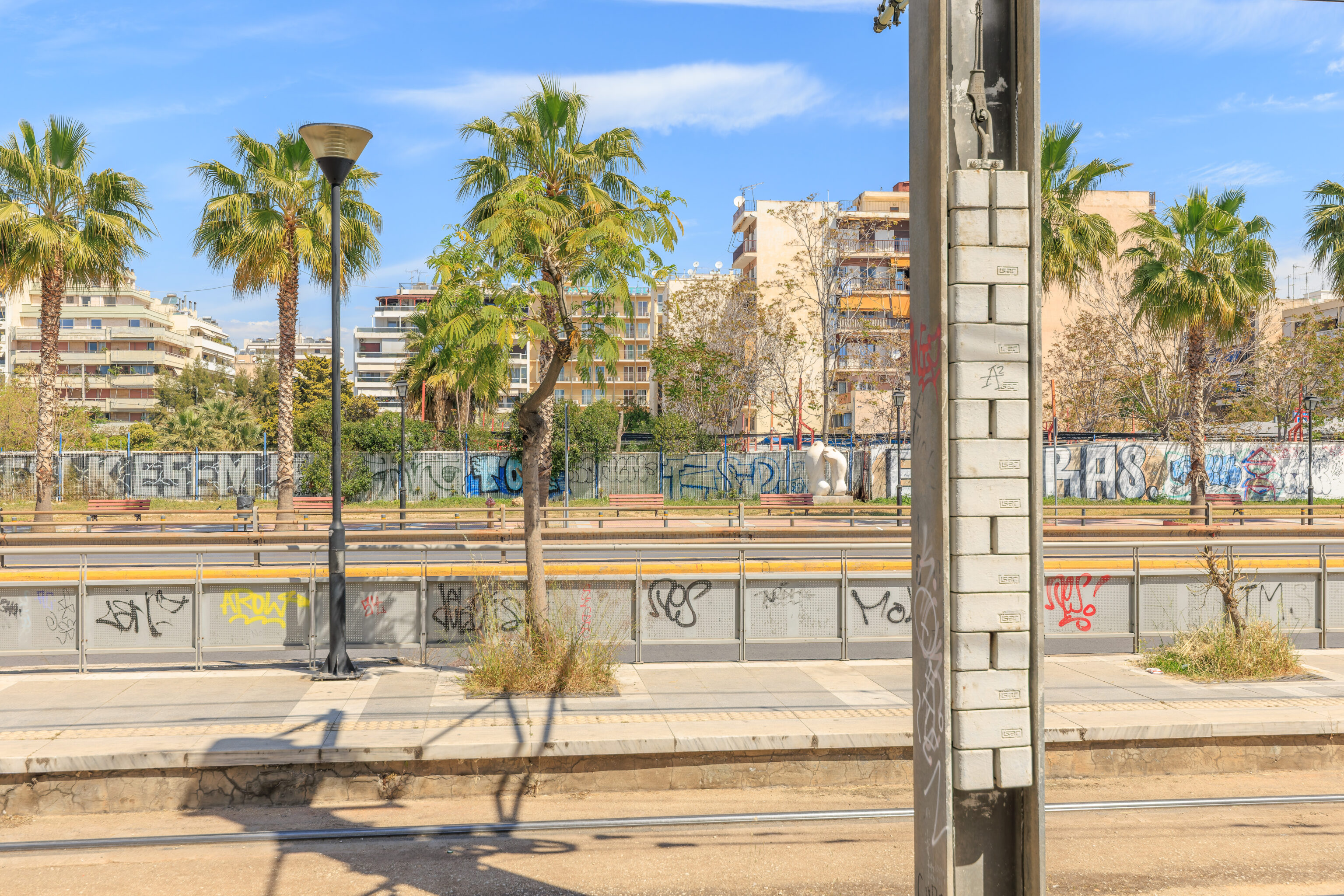
We walked over to the Neo Faliro tram station to the east of the Metro station. This required running across a multiple lane road as there was no crosswalk.
There was actually a station that would have been easier to access. The Peace and Friendship Stadium stop is to the southwest of the Metro station but it seems it can be accessed by an elevated pedestrian bridge. Note that this stop serves eastbound trams only, westbound trams stop at the Karaiskakis Stadium stop, which is right next to the stadium.
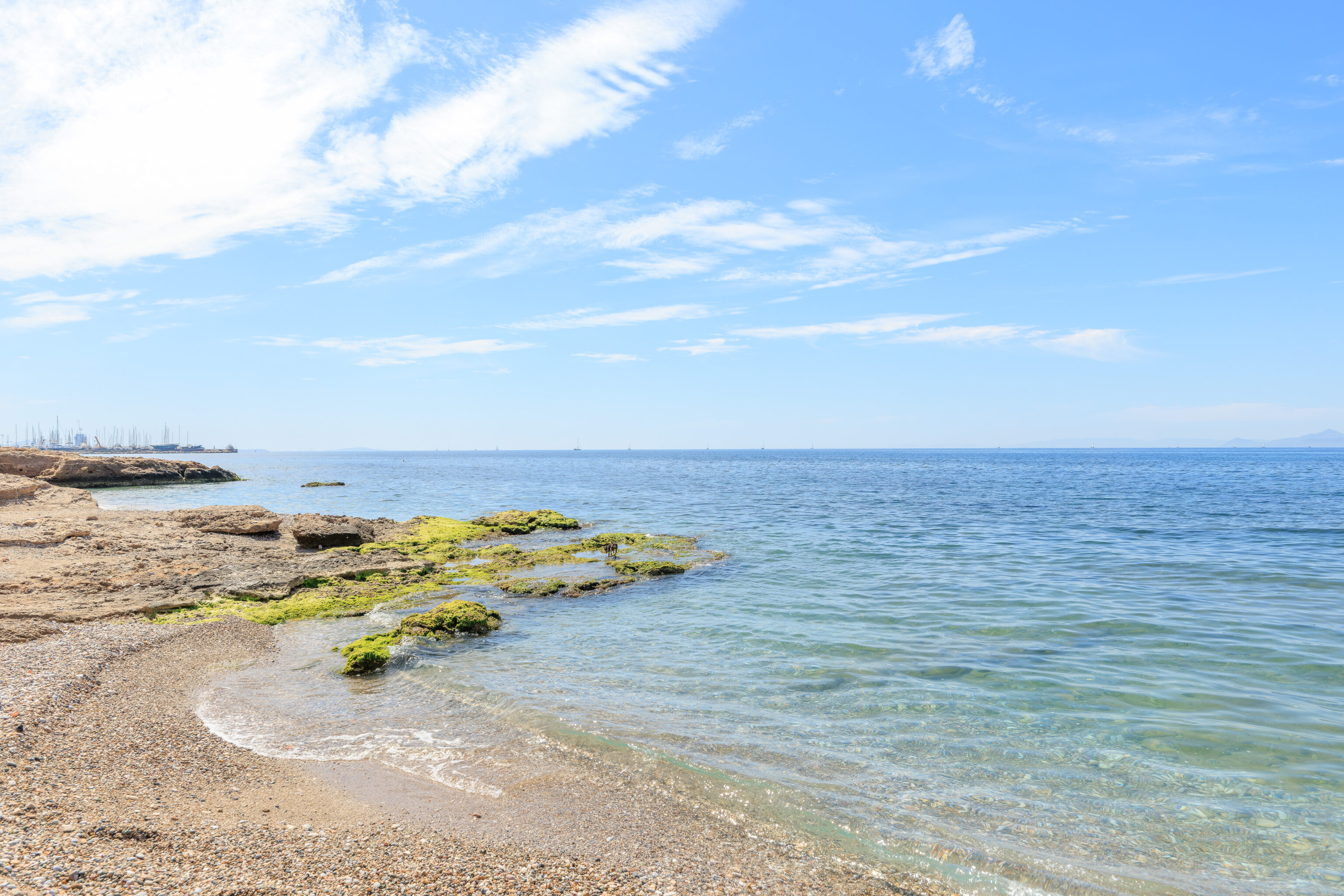
We took the tram to Φλοίσβος (Flisvos). The stop is right by the Mediterranean! We picked this stop as it is the closest easily accessible beach from Syntagma.
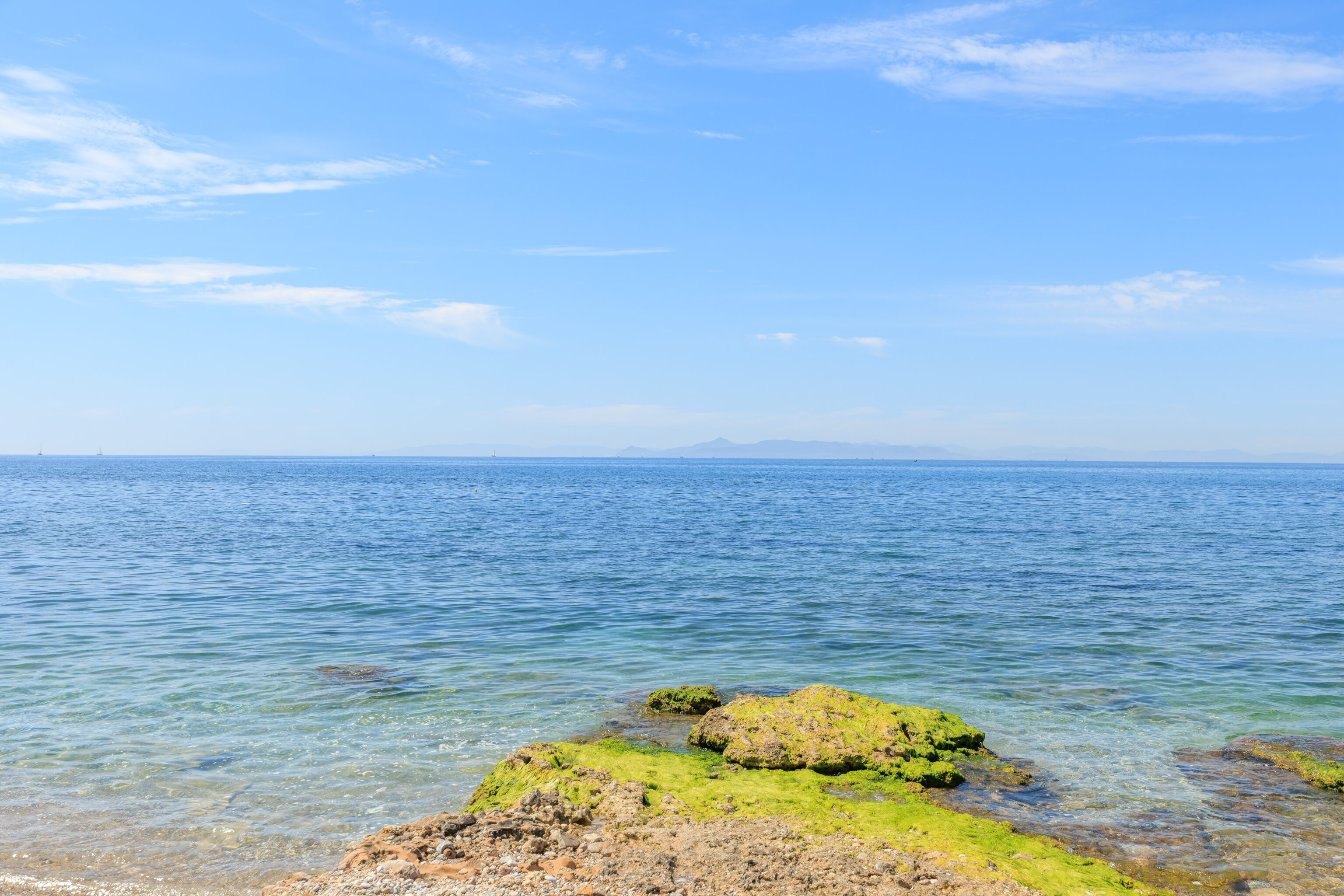
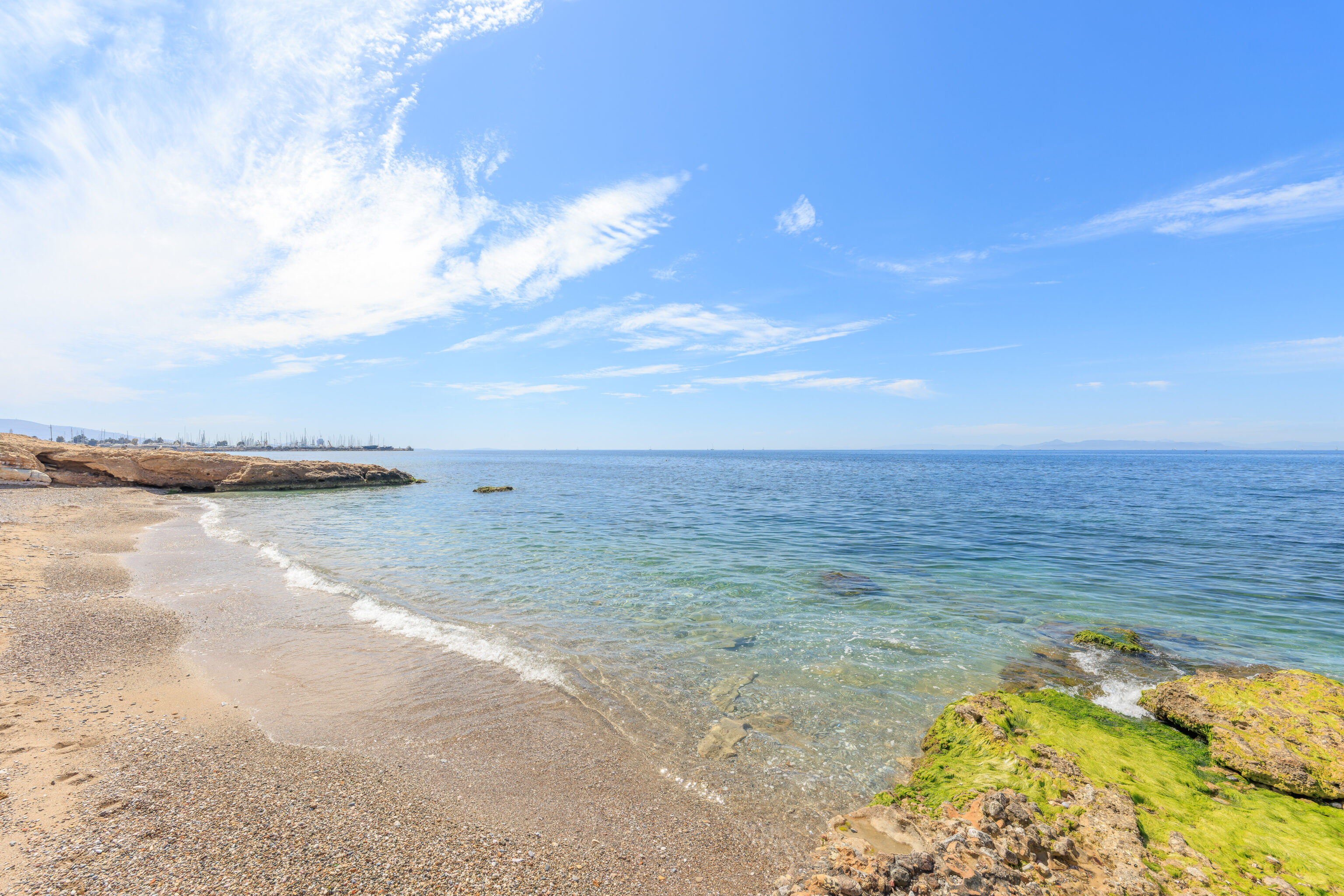
We walked a bit to the southeast along the beach.
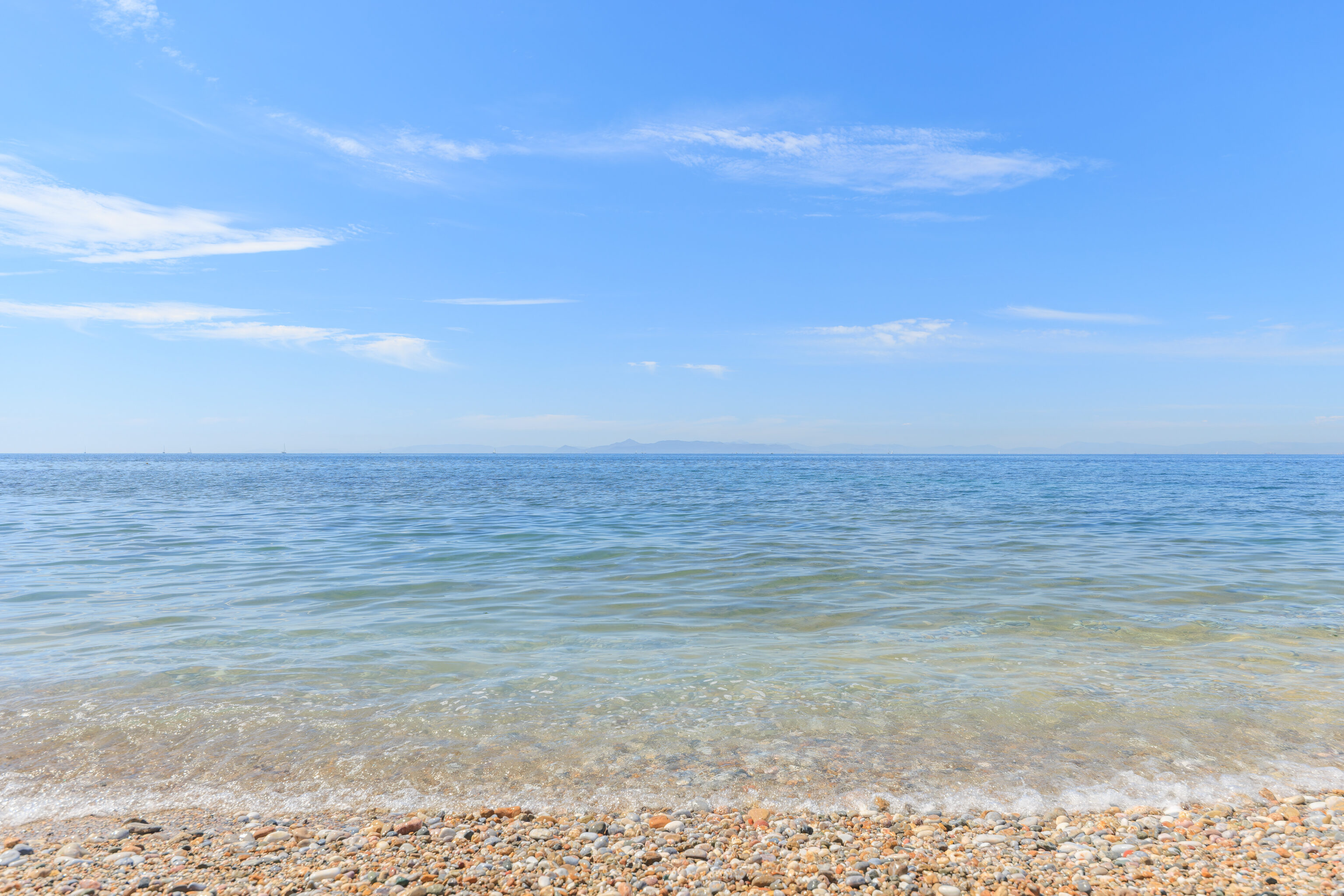
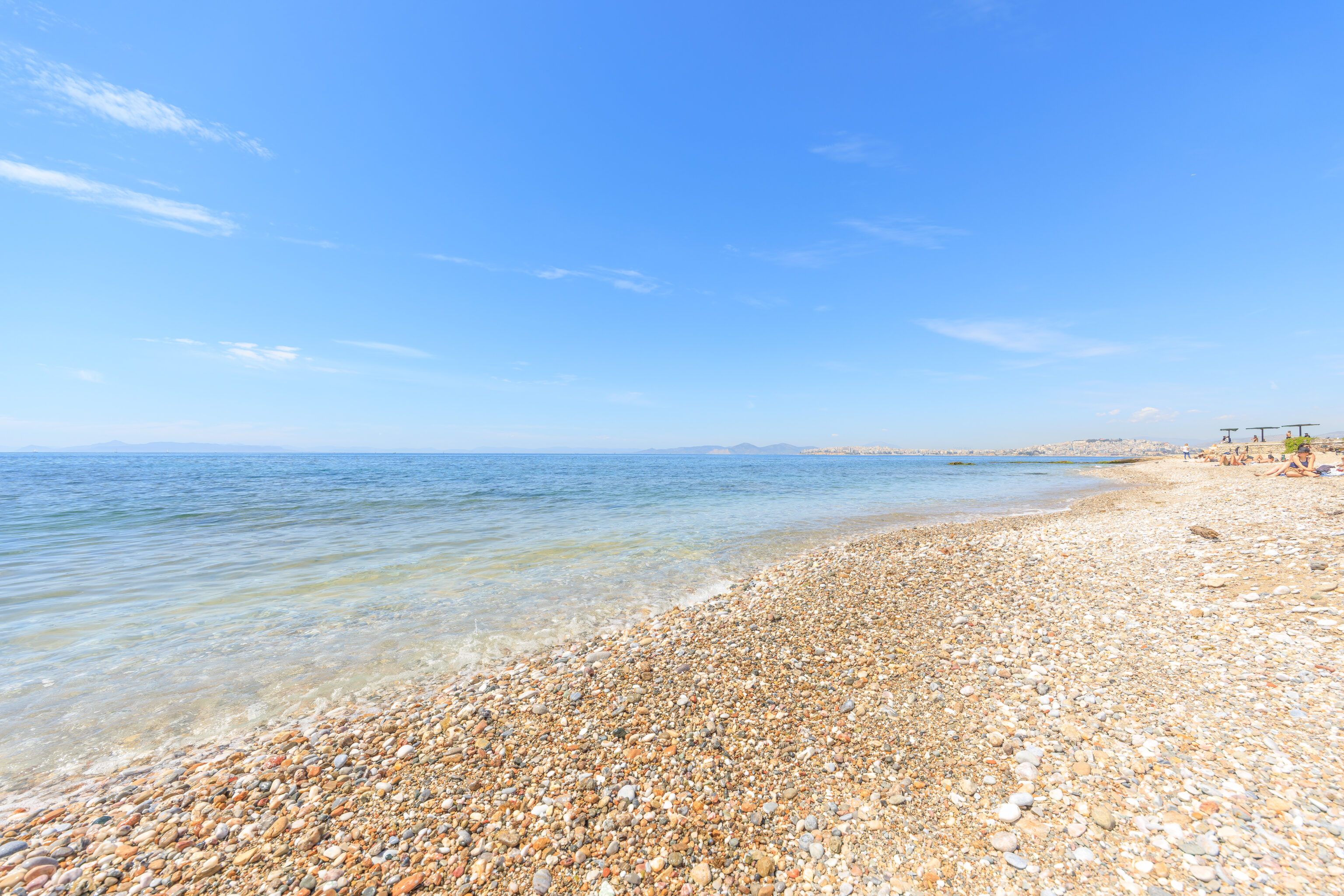
The sand here isn’t particularly good. Actually, there is no sand, its just mostly small smooth rocks. We did take off our shoes and walk into the water as it was our first time entering the Mediterranean. It was pretty cold.
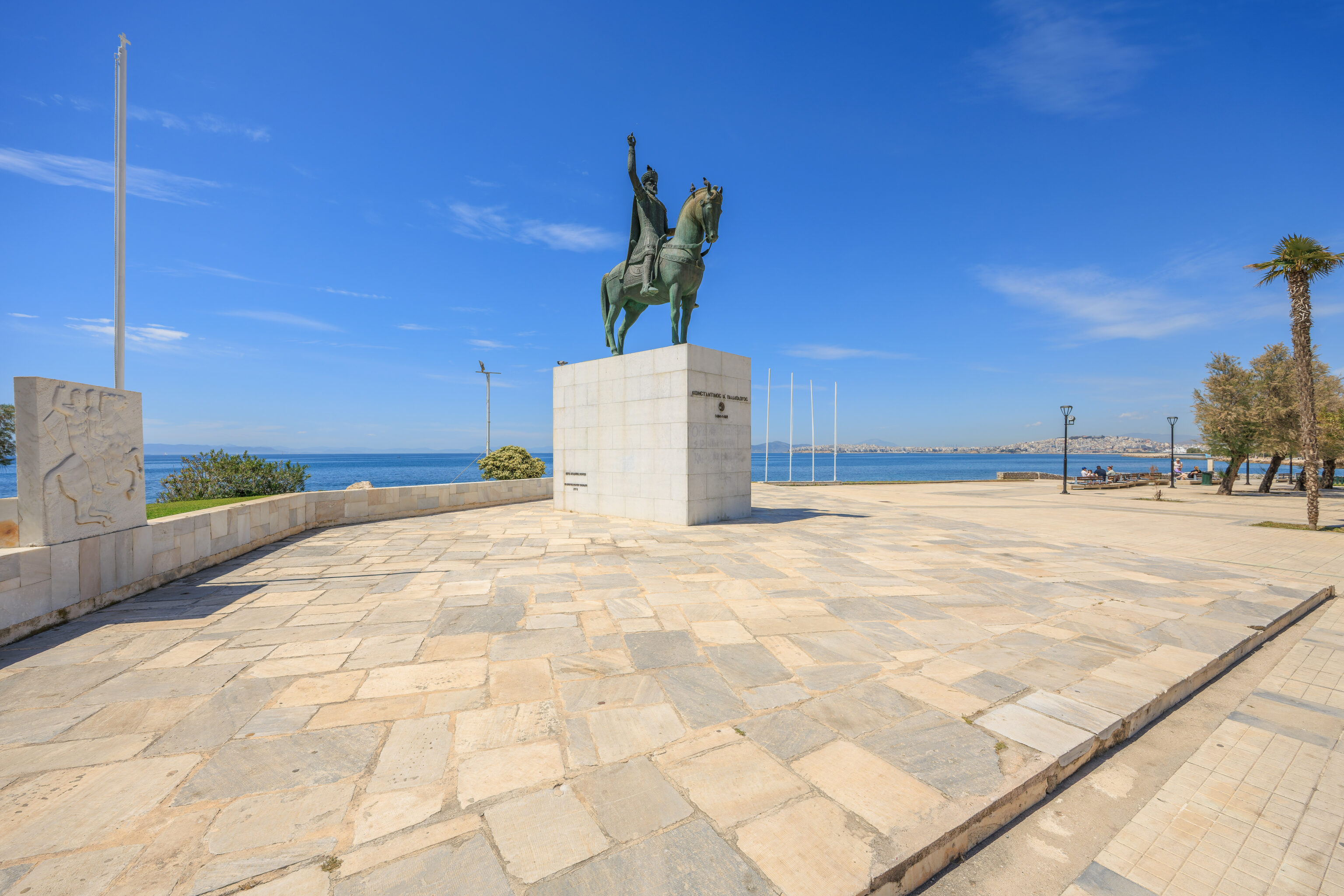
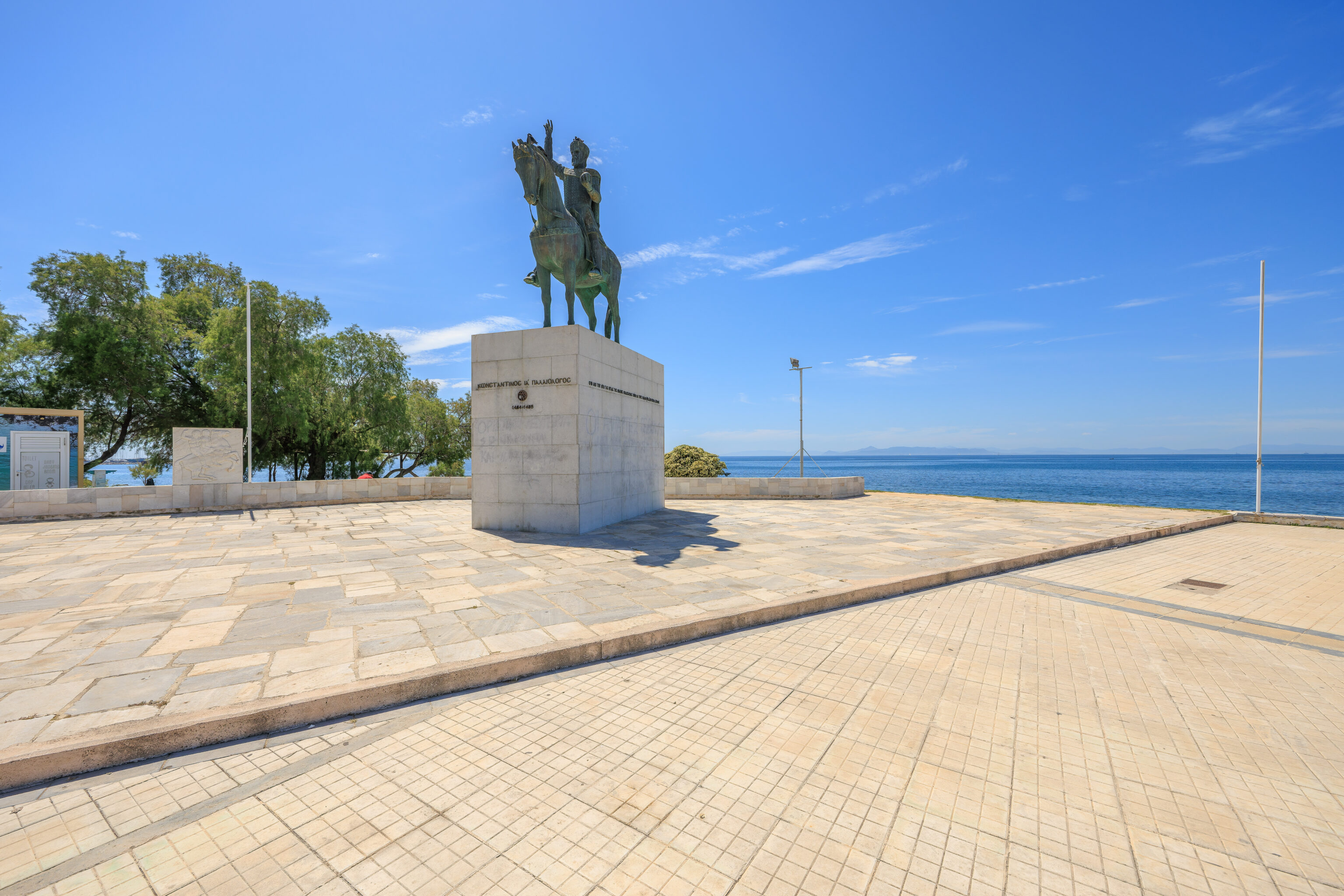
Rather than immediately take the tram back west, we decided to walk part of the way instead. This equestrian statue was just to the northwest of the Flisvos tram stop. It depicts Constantine XI Palaiologos, the last emperor of the Byzantine Empire before it fell to the Ottoman Empire in 1453.
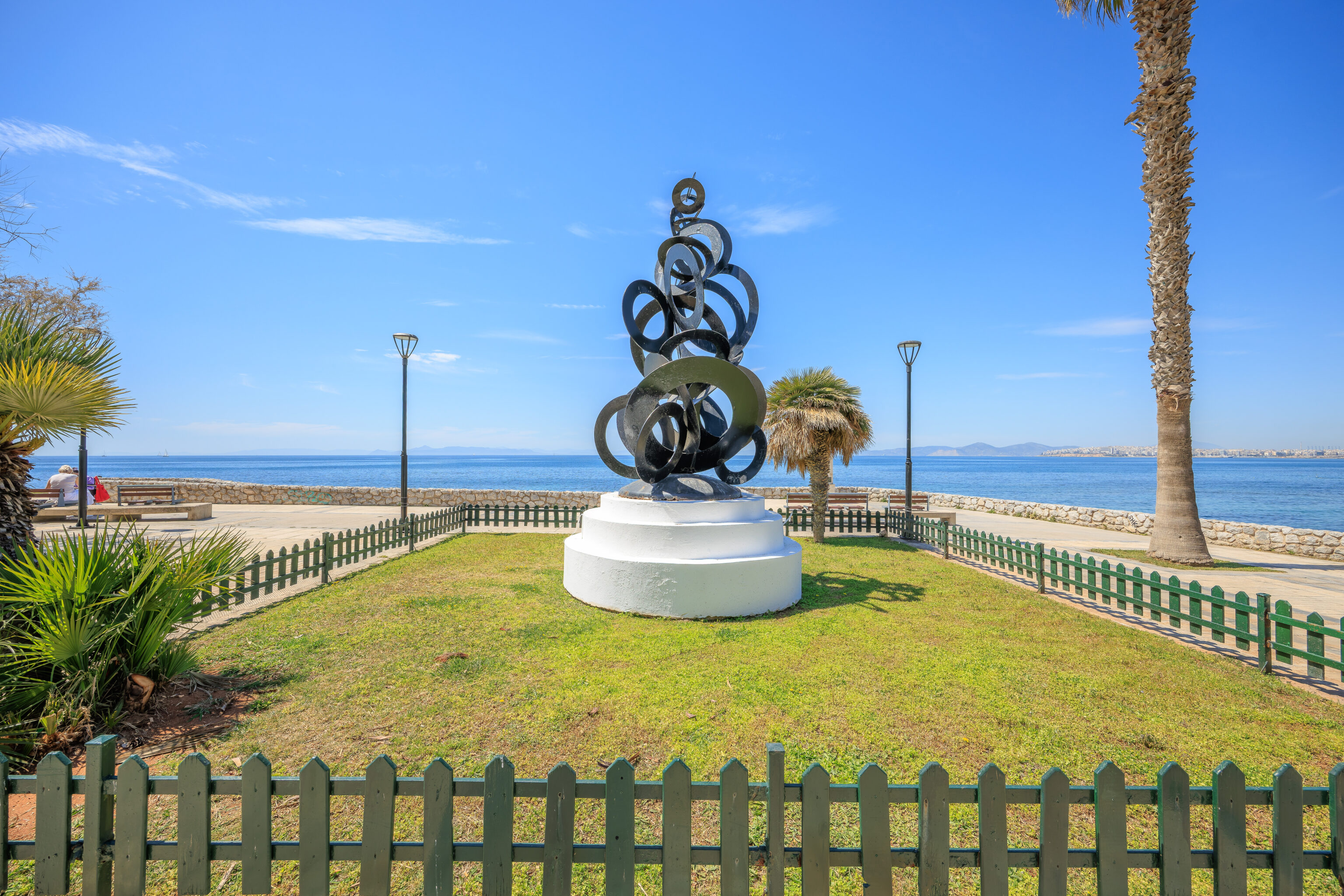
This sculpture of metal rings was a bit further to the northwest.
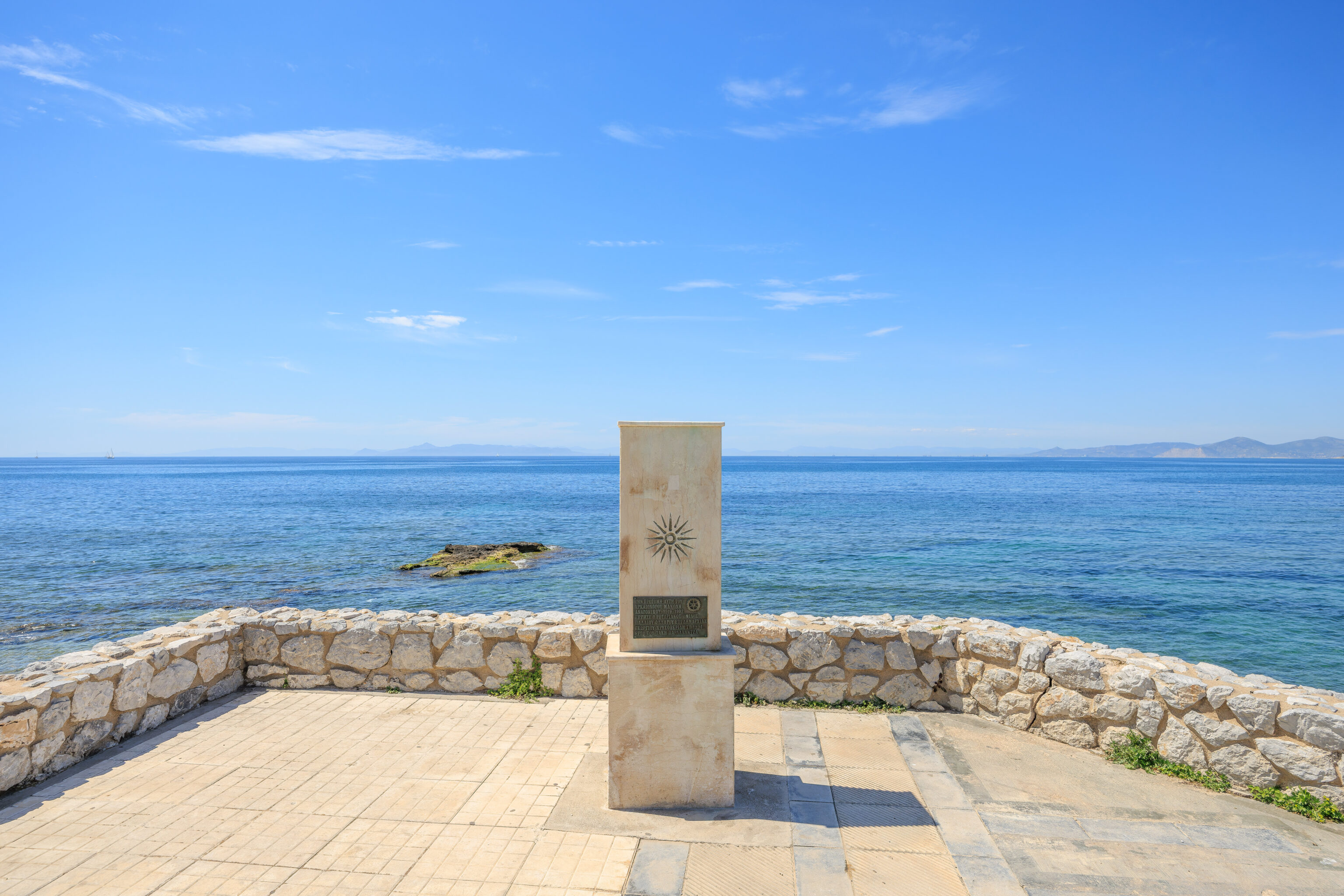
We didn’t know what this plaque said at the time other than it had the Rotary Club logo. It says, translated to English using Google Translate:
THIS BUST OF THE ARCHAEOLOGIST MANOLIS ANDRONIKOS 1919-1992 WAS ERECTED BY THE ROTARY CLUB OF PALAIO FALIRO UNDER THE PRESIDENCY OF GEORGIOS CHRYSOVERIDIS IN 1994.
WORK BY TAKIS PARLAVANTZAS
Presumably, the bust it references is on the other side. Oops!
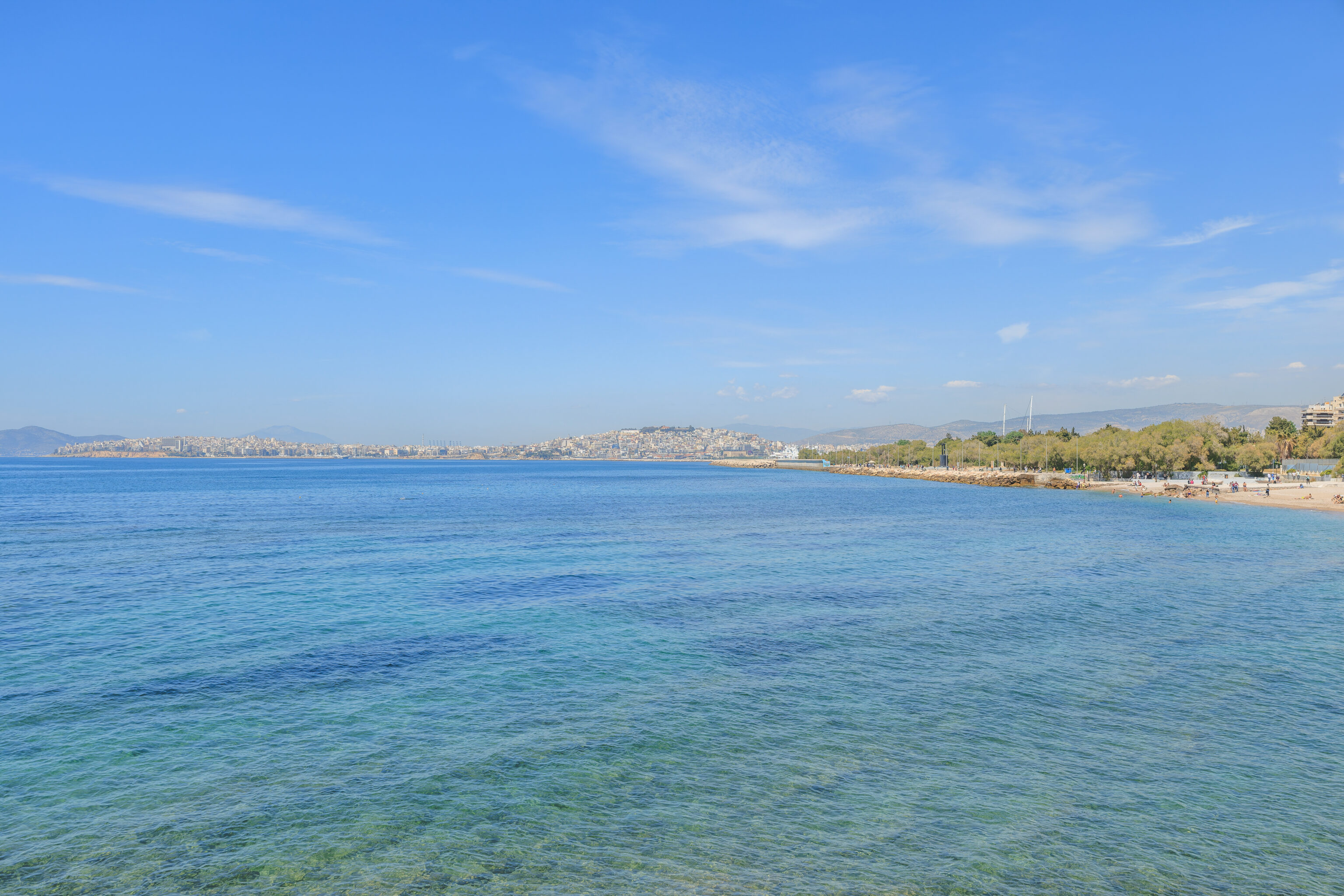
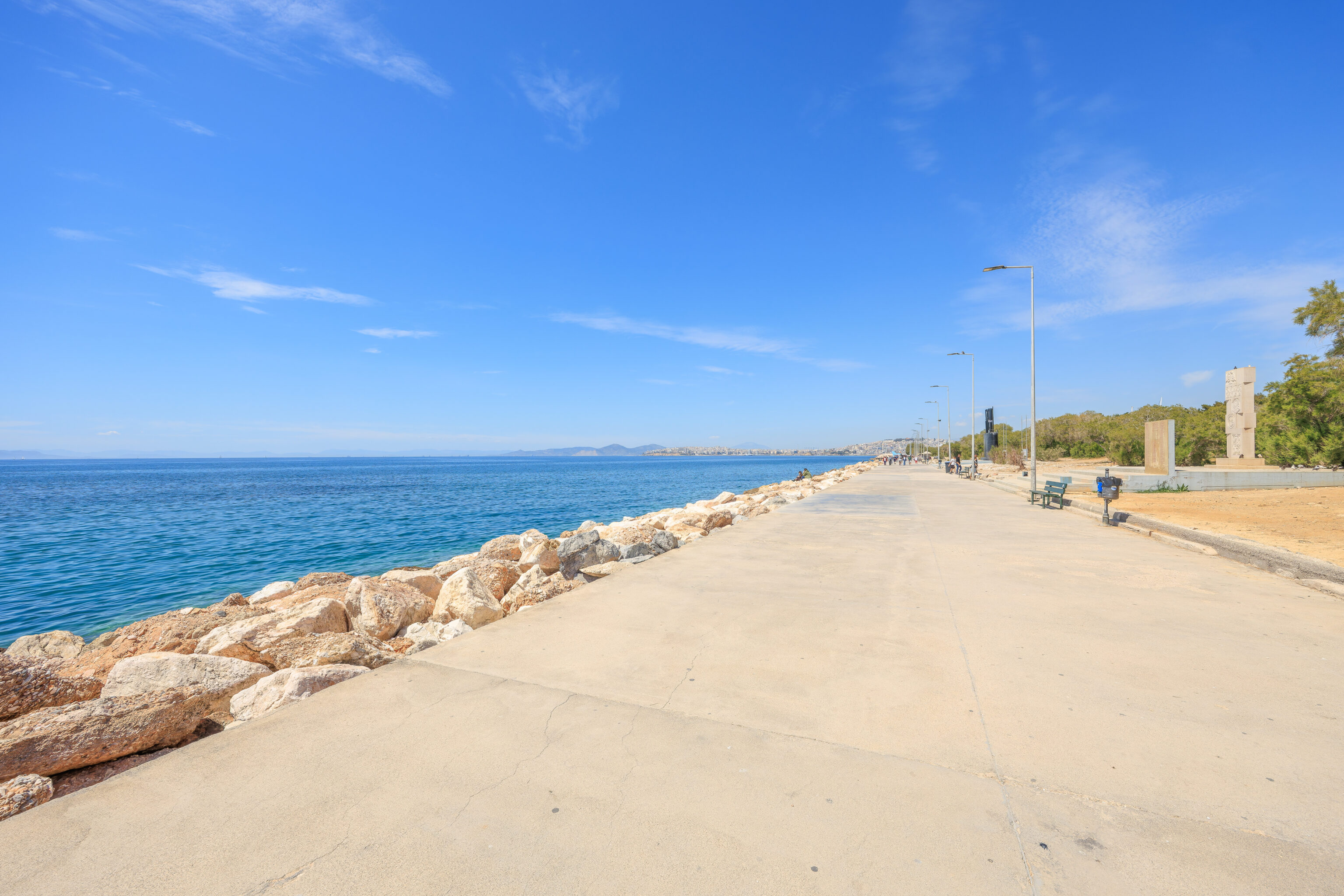
We continued walking by the sea. It was rather hot as there were few clouds in the sky.
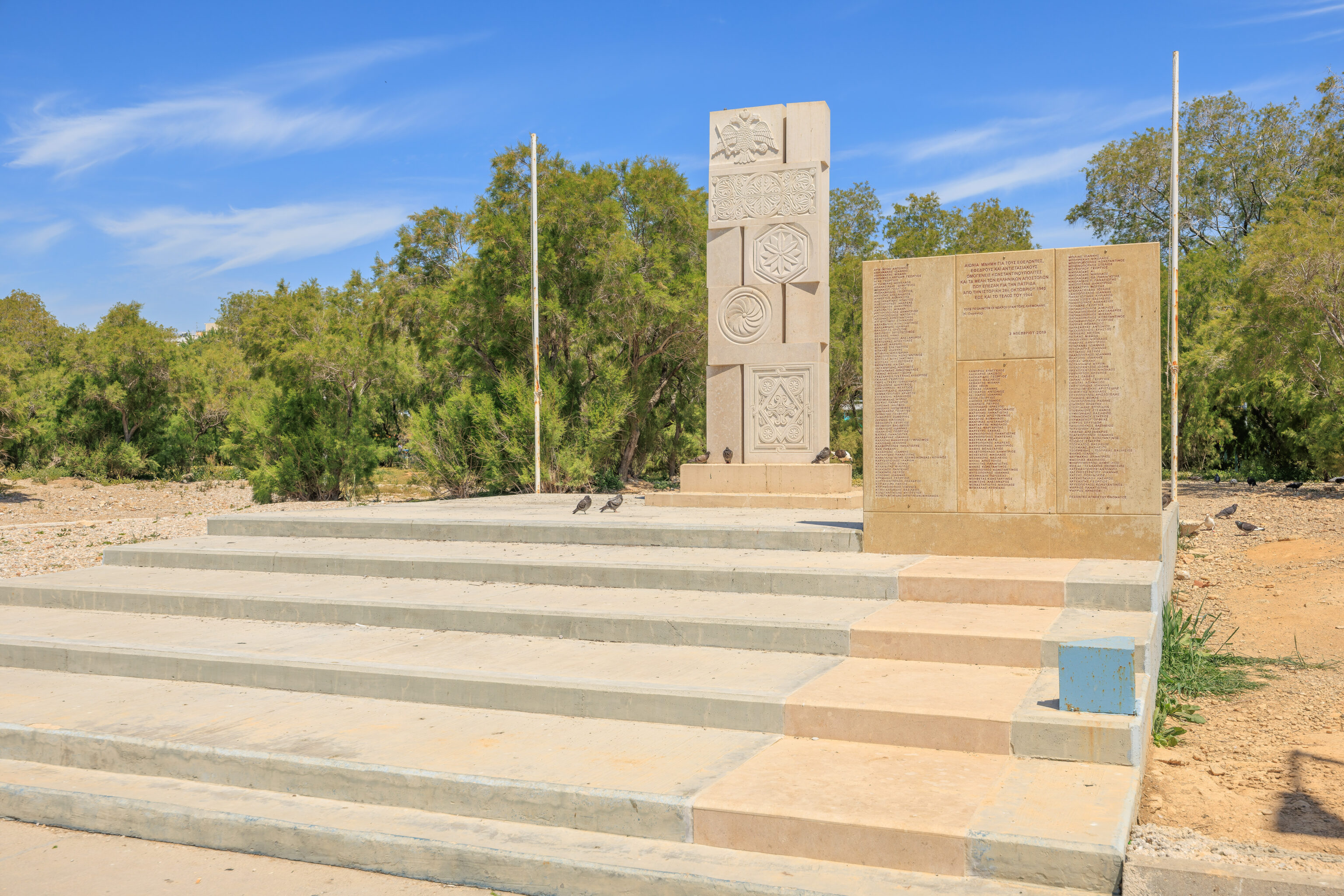
Unfortunately, Google’s translation of this memorial isn’t completely understandable. However, the Palaio Faliro municipality has an article that describes when this memorial was unveiled. It describes it as being dedicated to 196 reservists and volunteers from Constantinople who enlisted in the Greek Army prior to the Greco-Italian War. This ultimately led to the Nazi occupation of Greece during World War II.
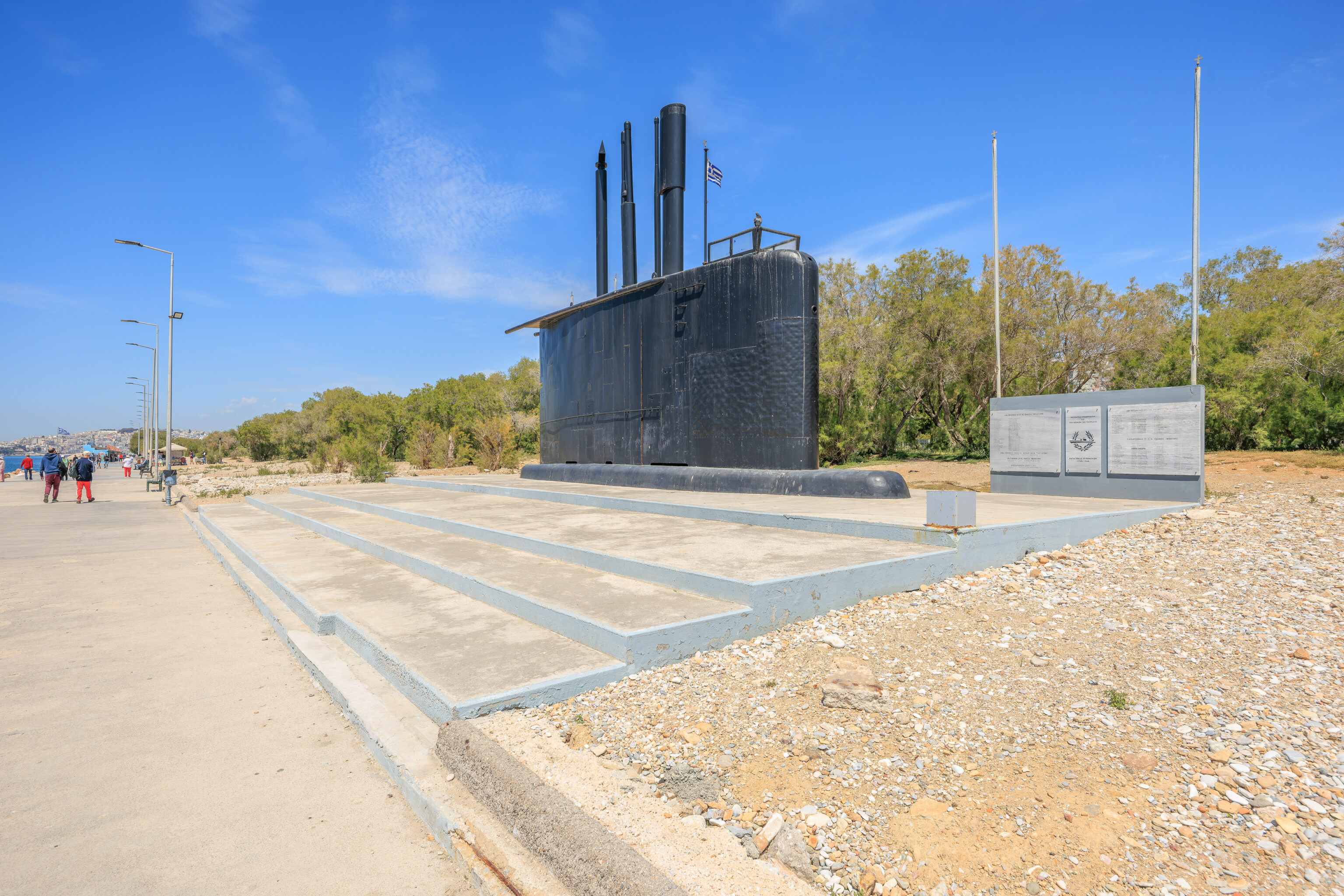
There was a submarine ahead! Or rather, just the sail of a submarine.

These plaques are a memorial to Greek submariners who were lost in World War II. Given that the Hellenic Navy had only six submarines during the war, these losses were significant.
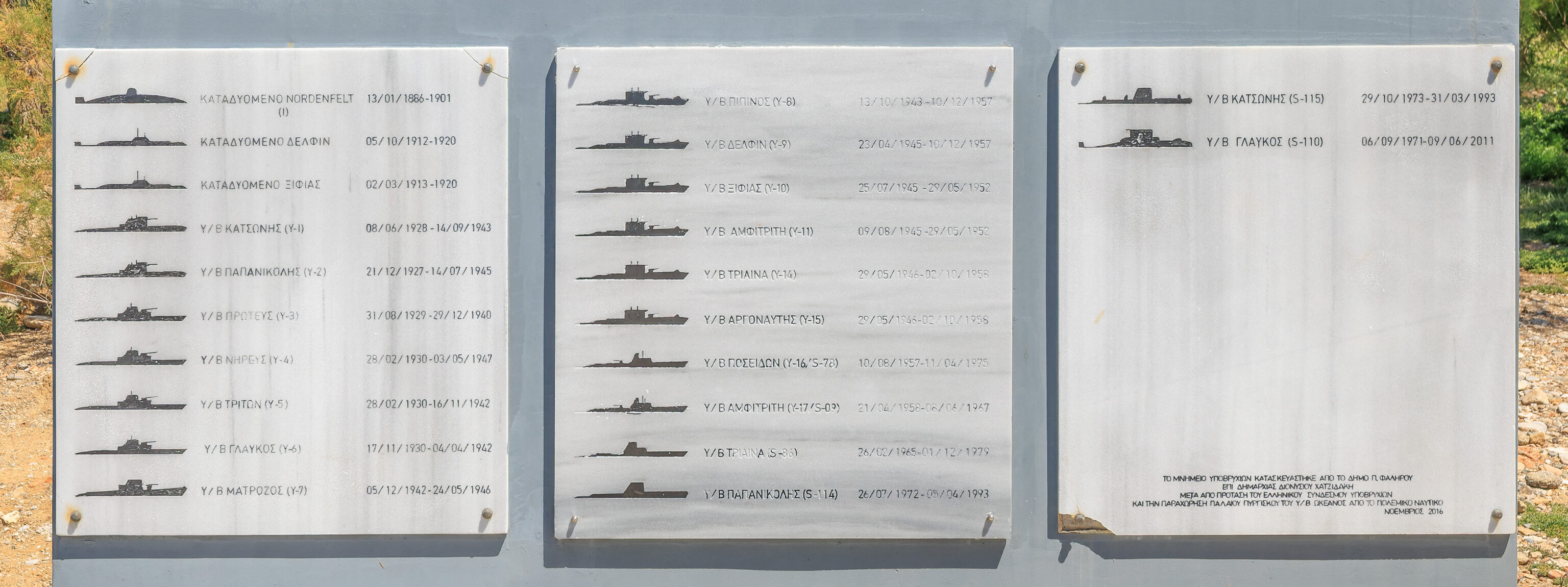
This seems to be a list of submarines in the Hellenic Navy that have been lost or decommissioned. Wikipedia‘s List of active Hellenic Navy ships shows that they currently have 9 submarines, none of which are listed on these panels. Additionally, Wikipedia’s List of decommissioned ships of the Hellenic Navy includes 24 submarines which are no longer in service, 22 of which are listed here. The two that are not here don’t have any details on the Wikipedia list, though they do appear on the List of pre-20th century submarines as being “Possibly available to the Hellenic Navy.”
The text on the rightmost panel reads, translated using Google Translate:
THE UNDERWATER MONUMENT WAS BUILT BY THE MUNICIPALITY OF P. FALIROS
UNDER THE MAYORSHIP OF DIONYSIOS HADJIDAKIS, FOLLOWING A PROPOSAL BY THE HELLENIC SUBMARINE ASSOCIATION AND THE CONCESSION OF THE OLD TOWER OF THE SUBMARINE OKEANOS BY THE NAVY, NOVEMBER 2016
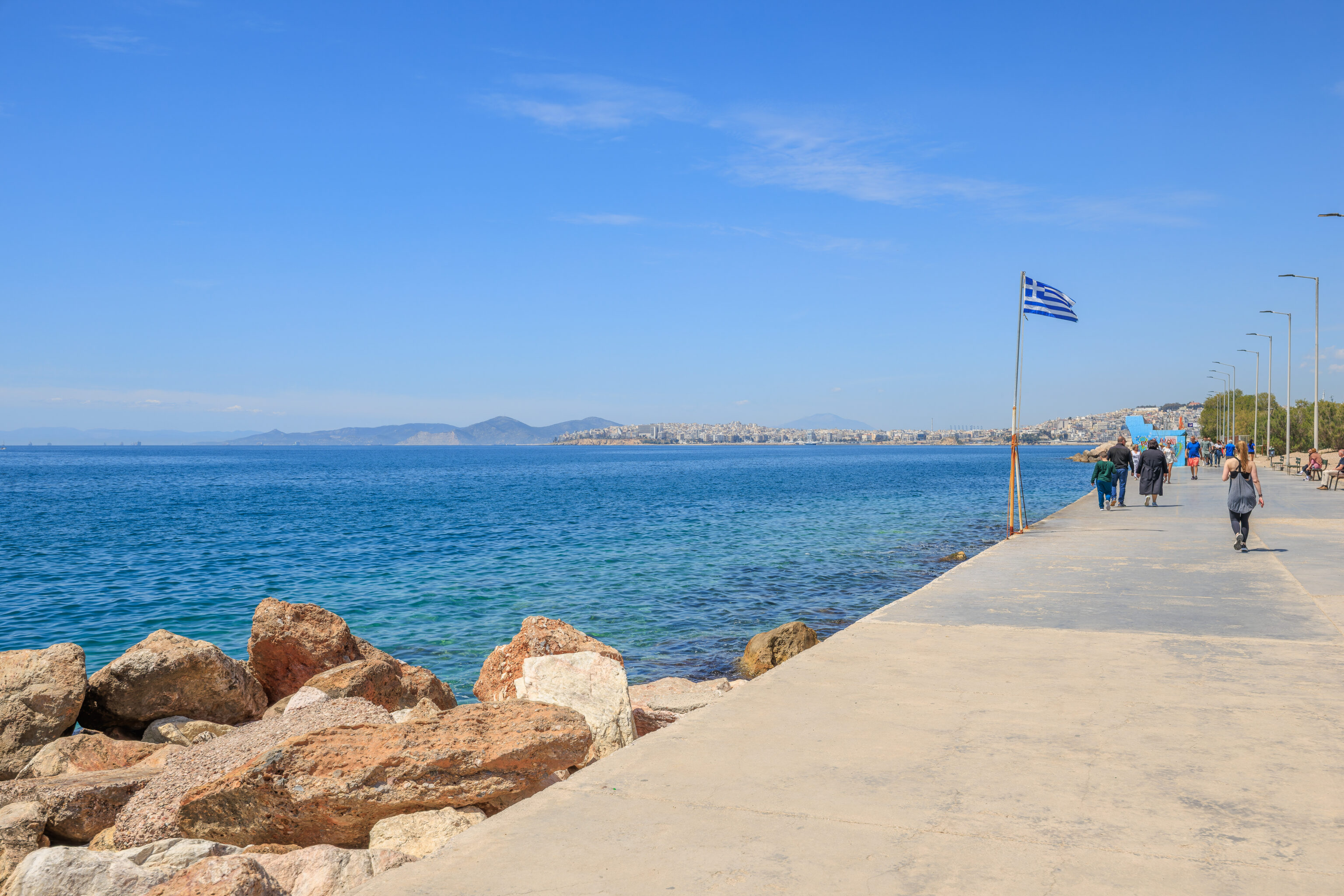
We continued walking on the path by the sea. Just beyond this point, there is a rather ugly portion of walkway where the view of the Mediterranean is blocked by some sort of long structure that looked a bit derelict.
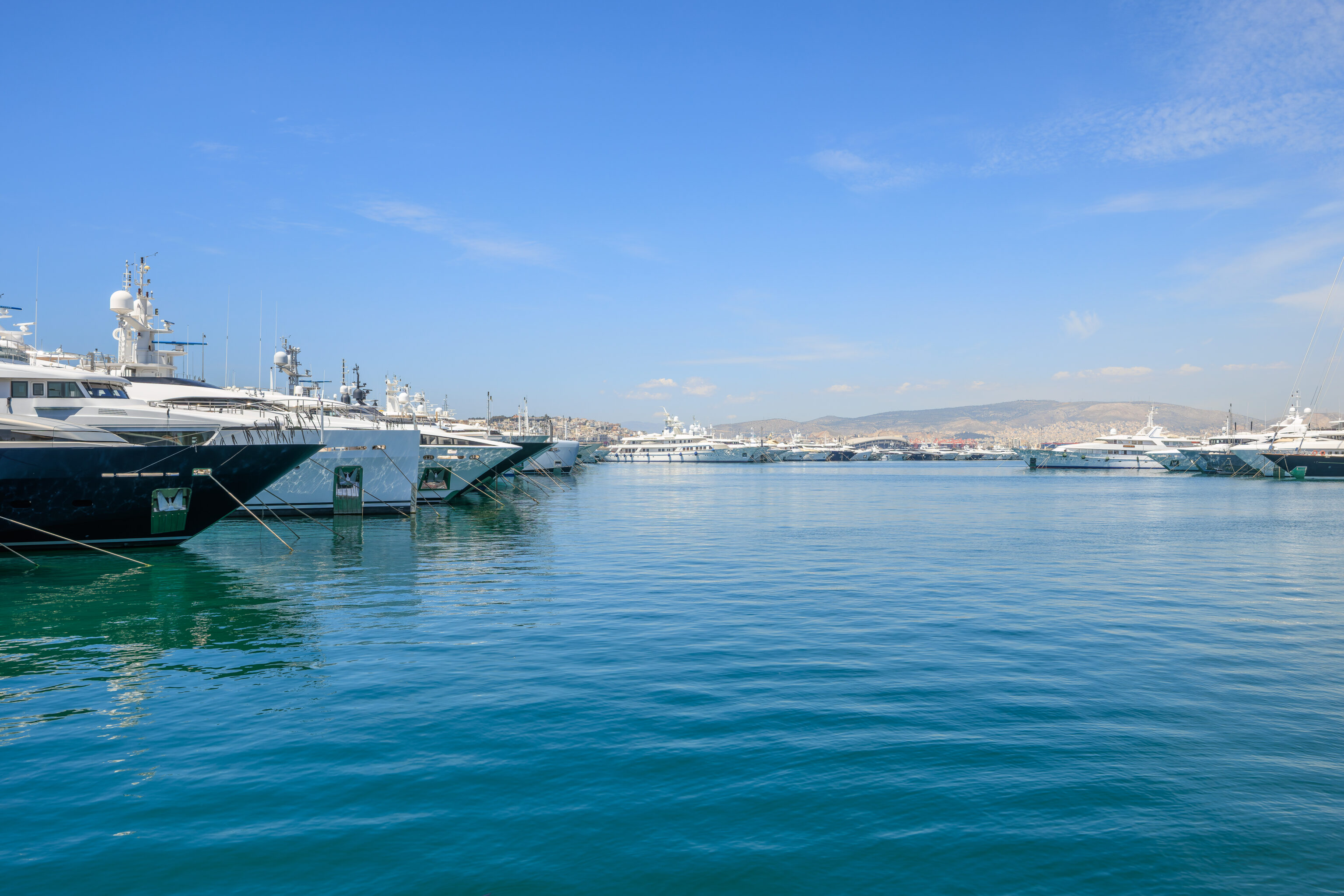
We followed the path northwest until we reached a junction. Continuing on would take us on a combination pier and breakwater, the southwestern edge of the Flisvos Marina. We turned right to continue walking by the water with land on our right side. There were some very expensive looking vessels moored here!
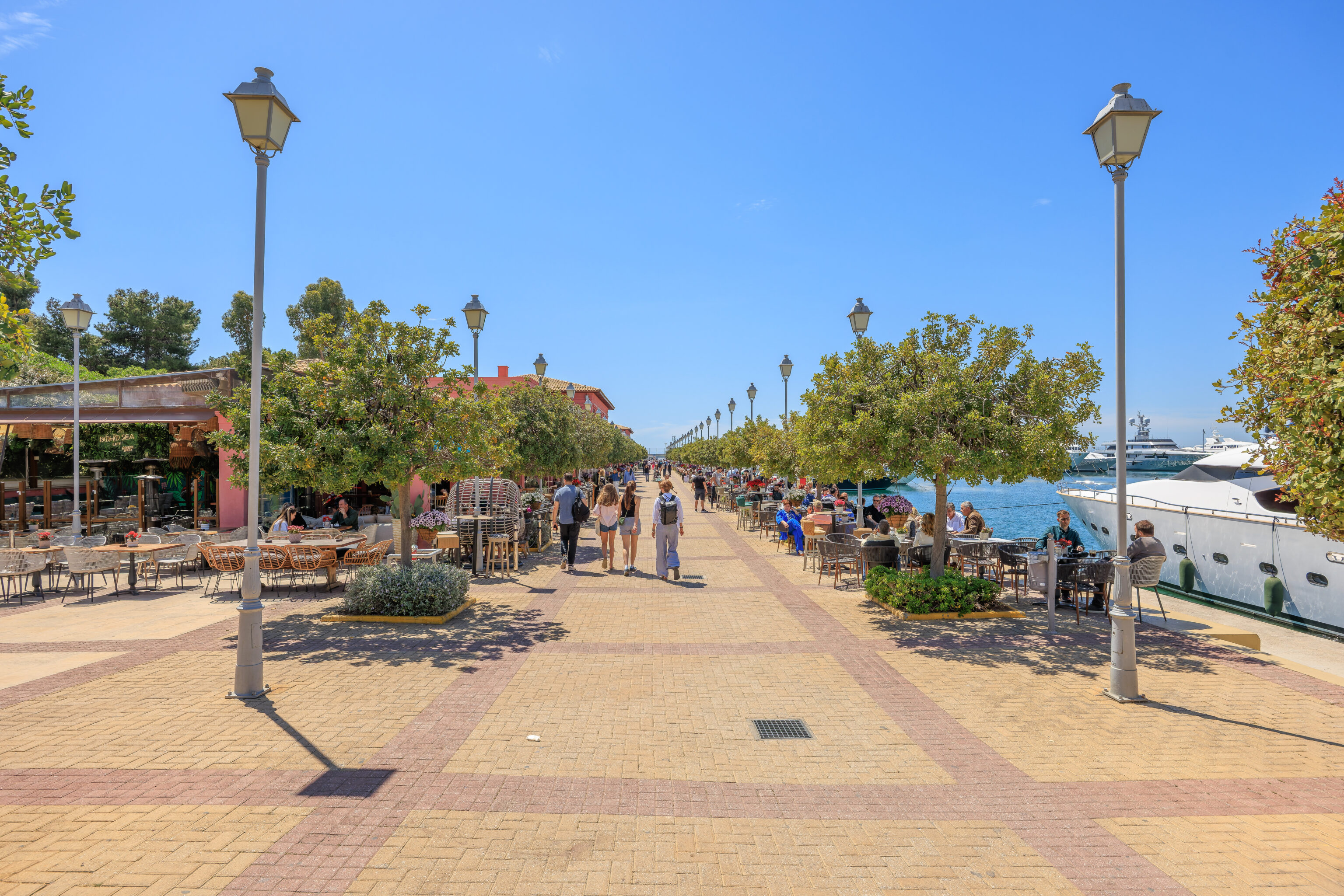
There are some shops and restaurants along the water at the marina. A few have decent ratings on Google Maps, the others aren’t so good.
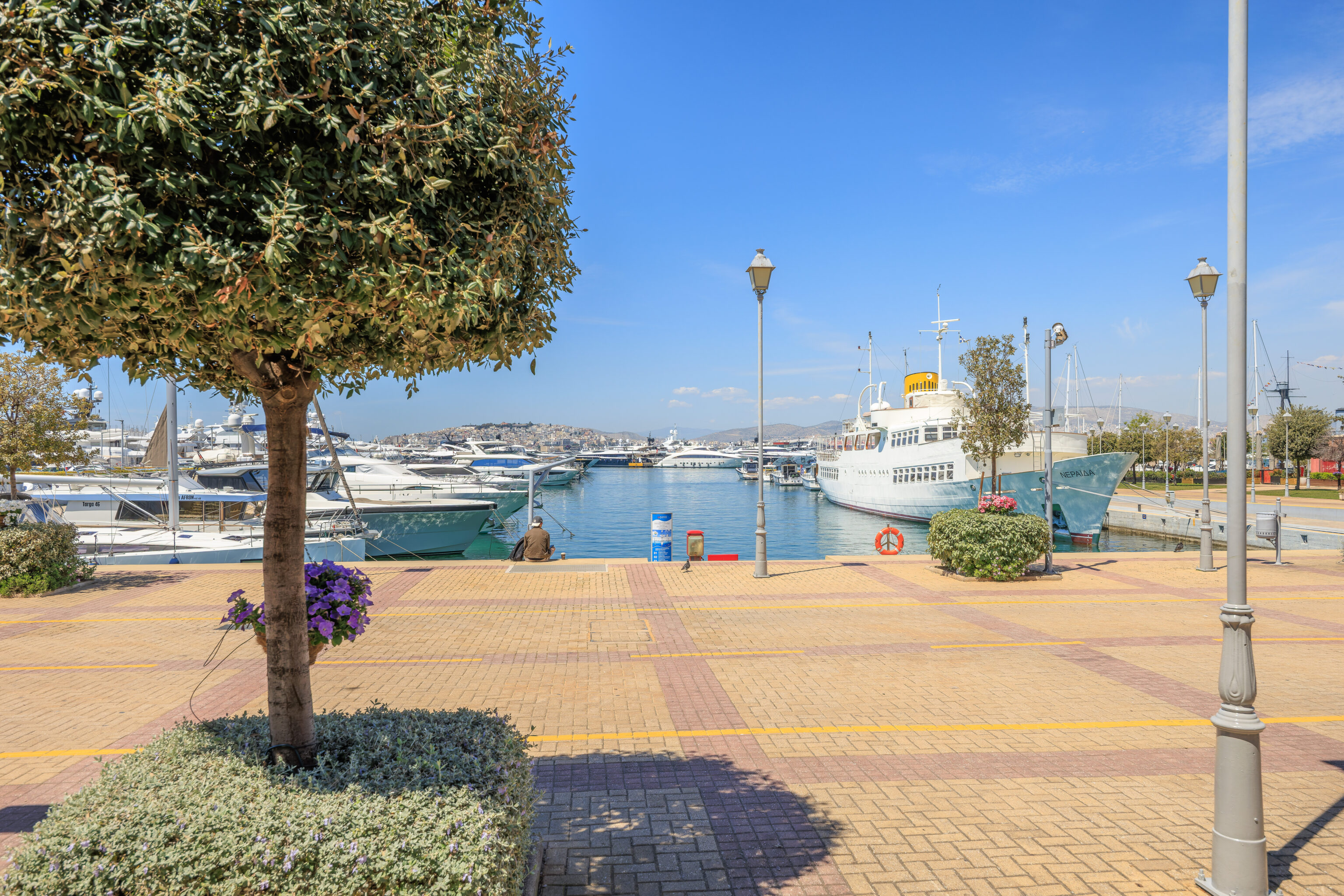
The small ship on the right is the Neraida, currently a floating museum ship. According to its website, the museum focuses on Yiannis Latsis, the billionaire shipping tycoon who owned the Neraida, and the history of the ship.
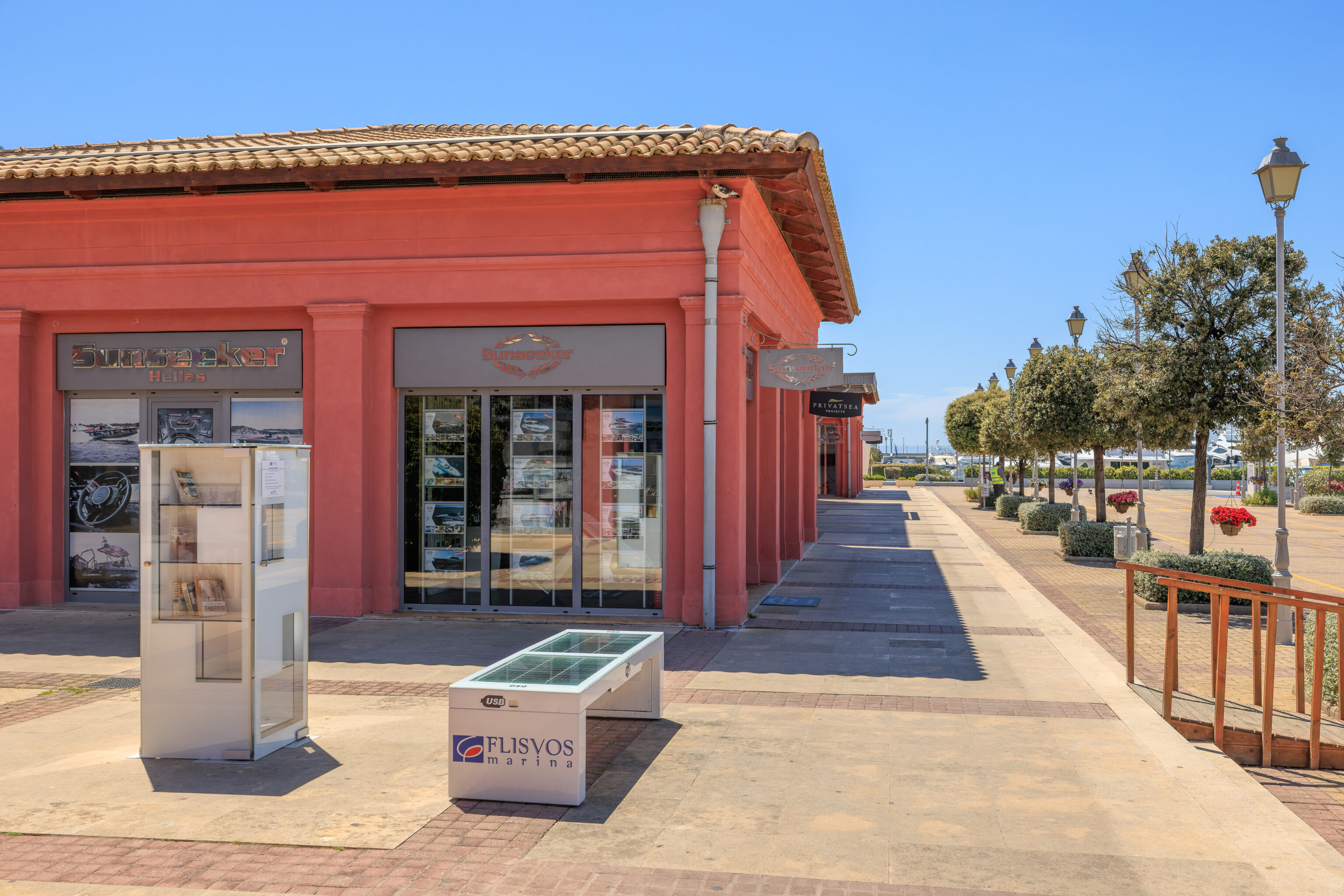
This bench at the marina was interesting as it has solar panels. The power generated can be used to charge phones via built in wireless charger and, presumably, at least one USB port as it has a big USB logo on the side! The wireless charger does work. Presumably, the bench has a battery so you can sit and charge at the same time.
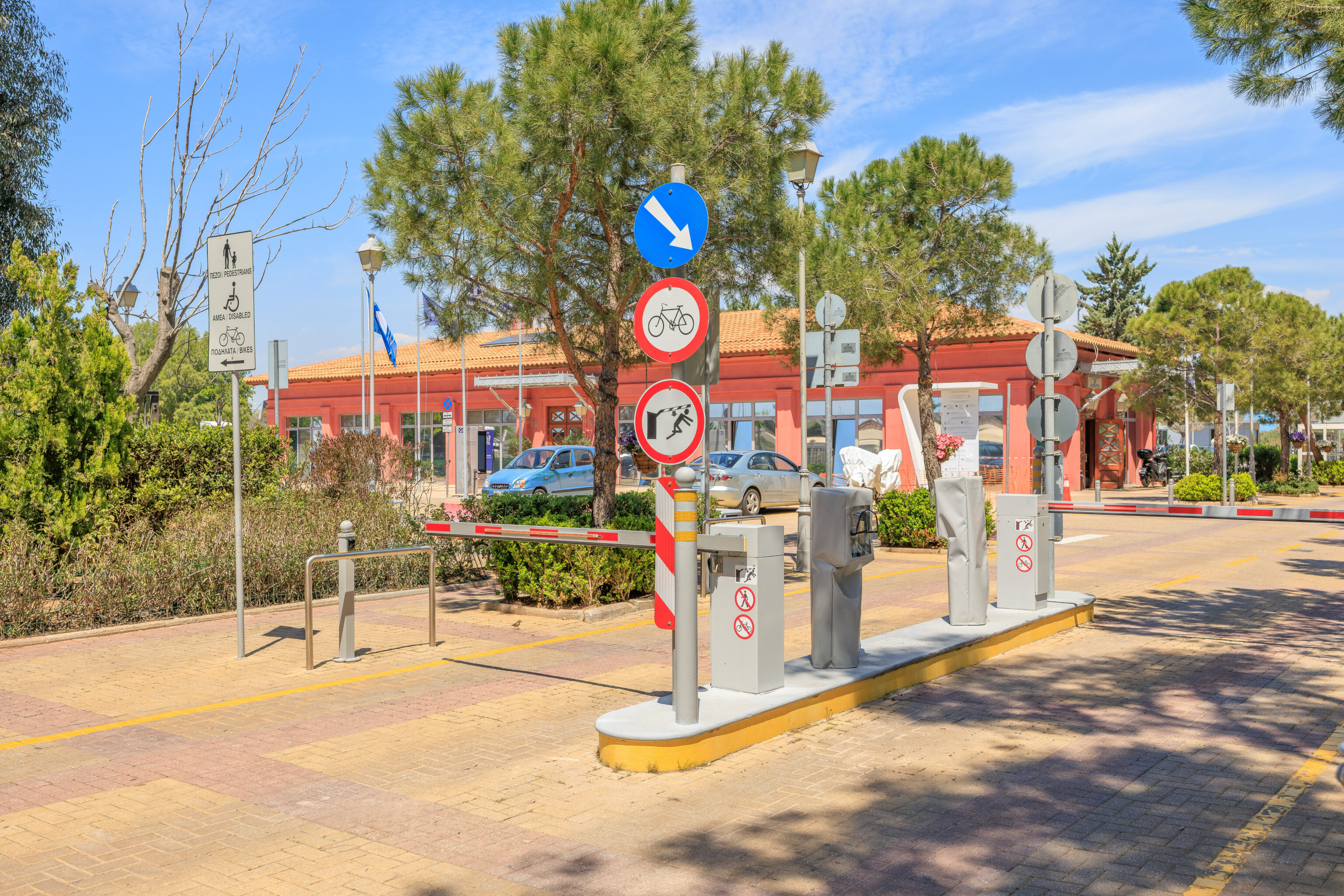
We continued on, walking past a vehicular gate. The warning sign is amusing.
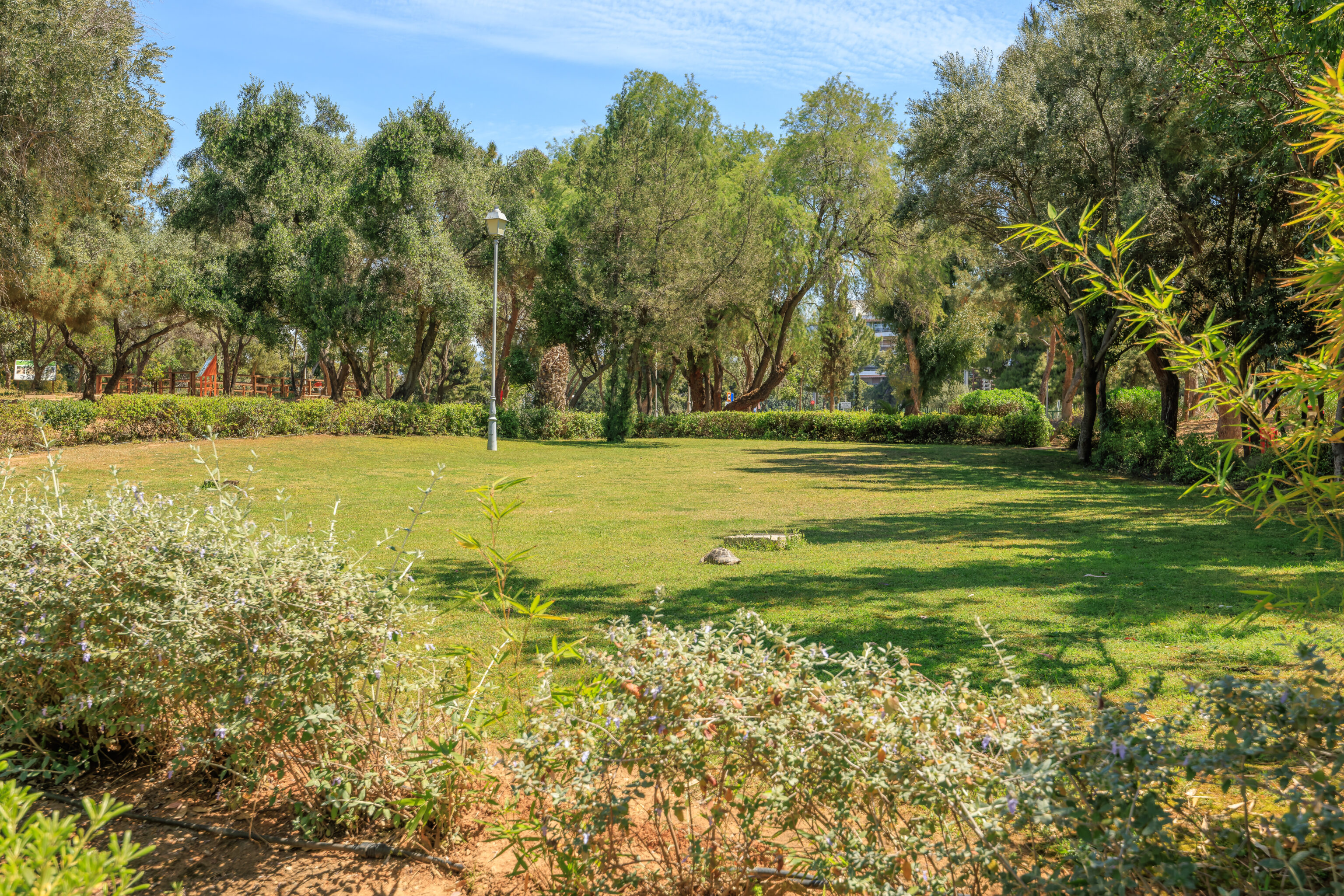
We walked by a park area to our right where we saw a turtle slowly walking away.
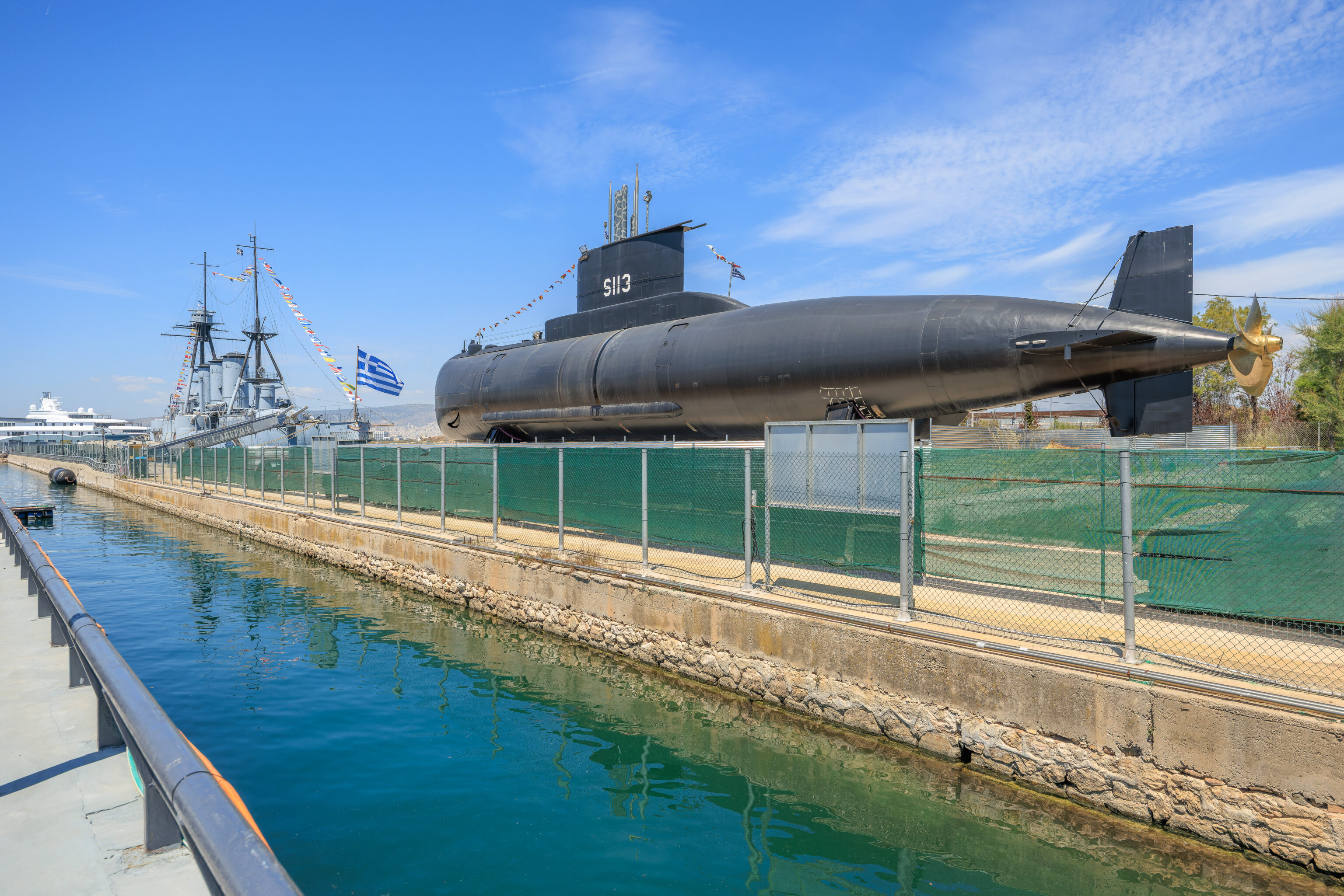
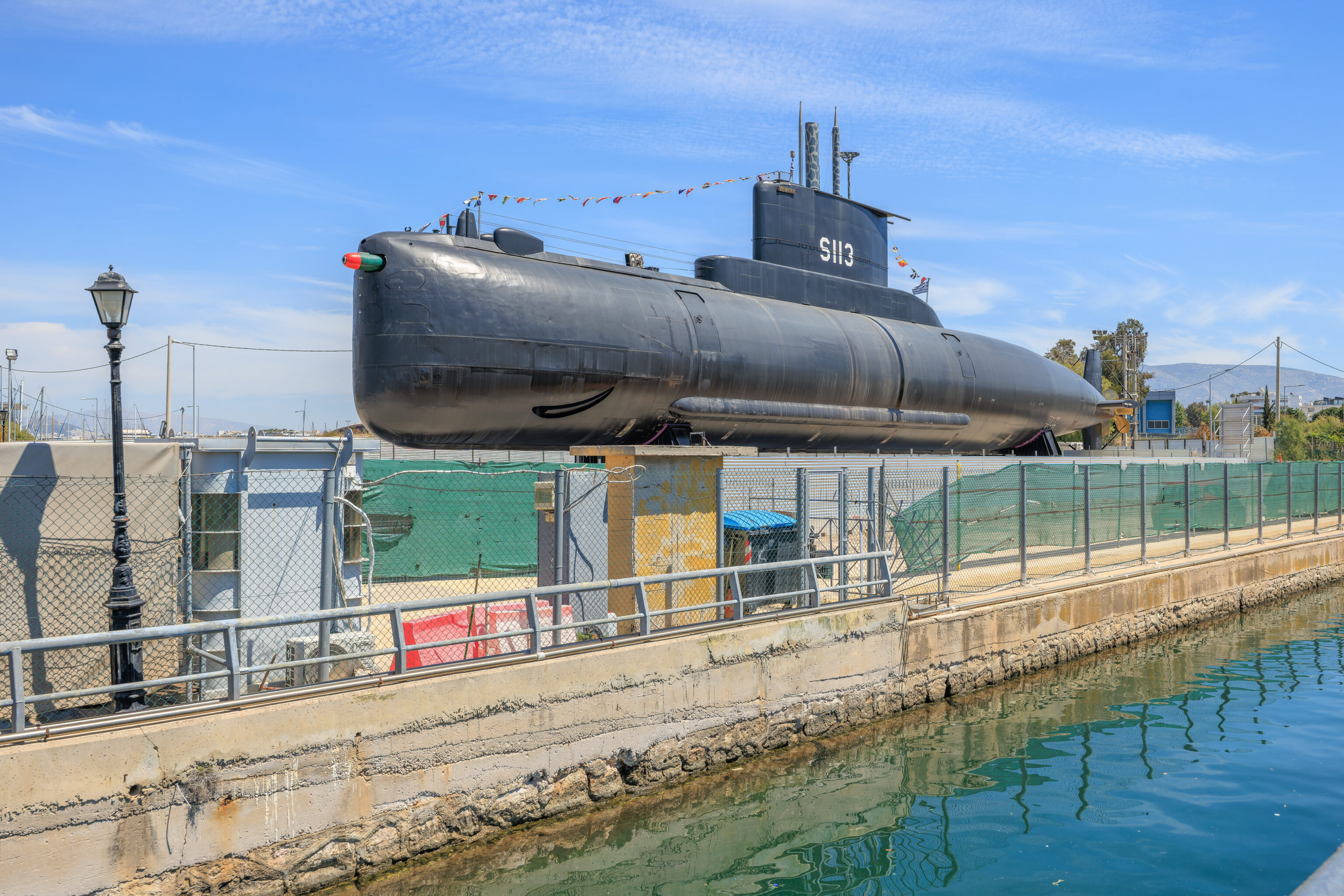
We turned left at the northeastern edge of the marina to take a closer look at this submarine out of water. This submarine, S-113, is the ΠΡΩΤΕΥΣ (Proteus). It is a Type 209 made by the Germans and was decommissioned in 2022 after 49 years of service. It was actually just moved here on January 31st to become a museum ship1.
An interesting feature of this ship as currently displayed is that it has a torpedo coming out of one of its bow torpedo tubes!
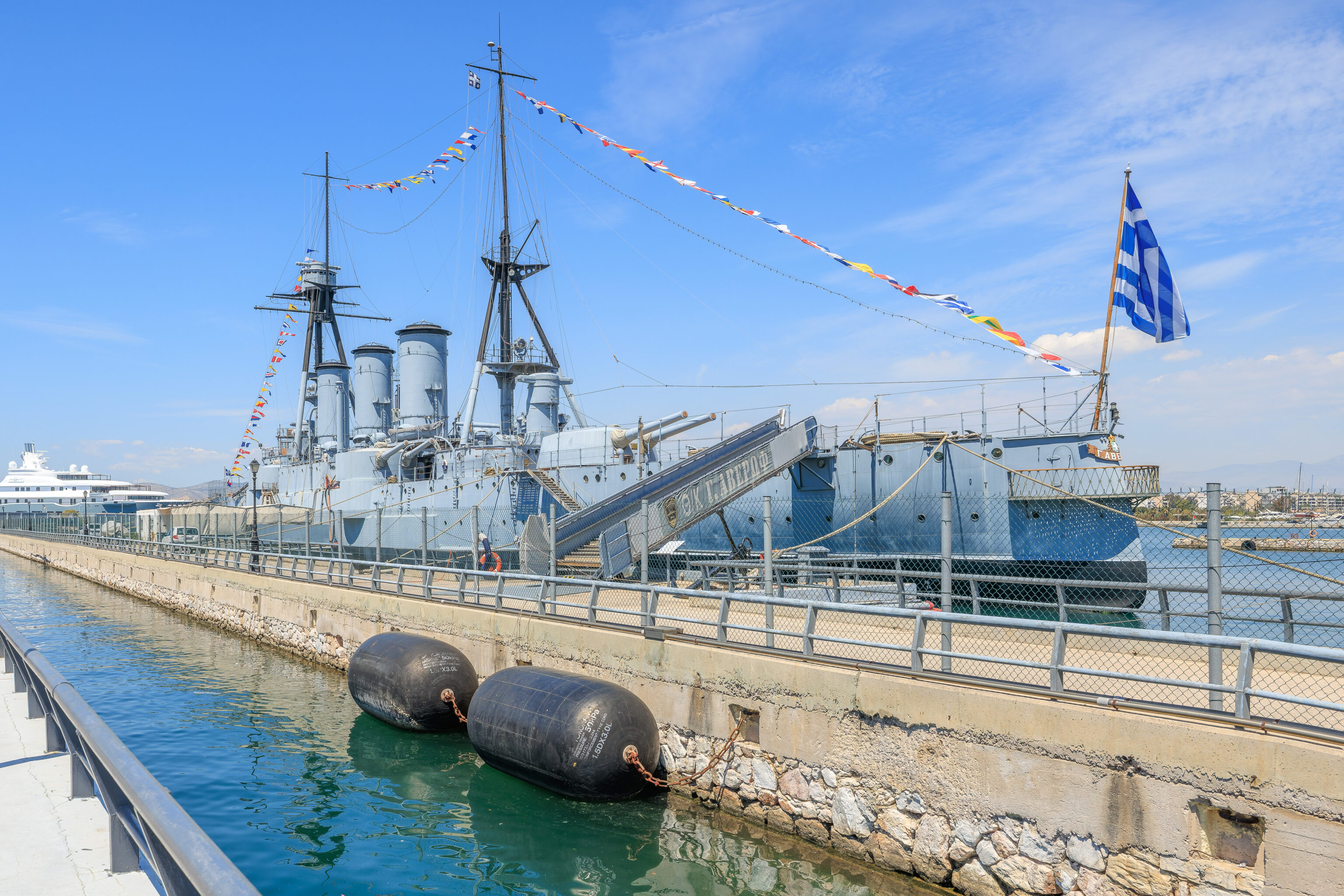
In front of the submarine in the water is the Georgios Averof, a Greek armored cruiser built by the Italians in 1910. Along with the Proteus, it is part of the Floating Naval Museum. This ship is named after Georgios Averoff, another business tycoon, who donated funds for Greece to purchase this ship from Italy.
After taking a quick look from here, we backtracked a bit to catch a tram back at the nearest stop, Τροκαντερό (Trocadero). This time, we got off at the Karaiskakis Stadium stop which is directly next to the Neo Faliro Metro station. We then took the Metro back to Monastiraki.
Athens
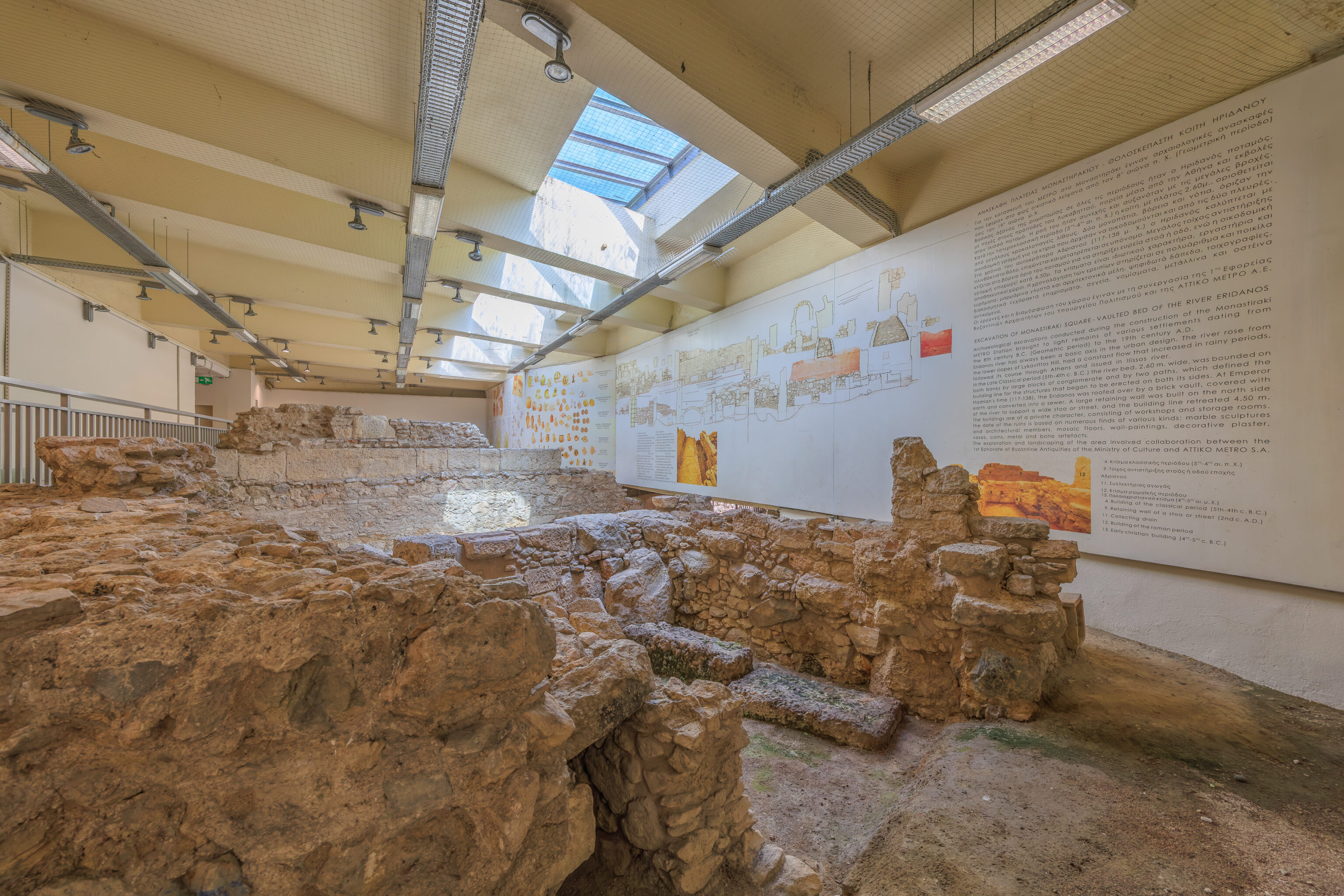
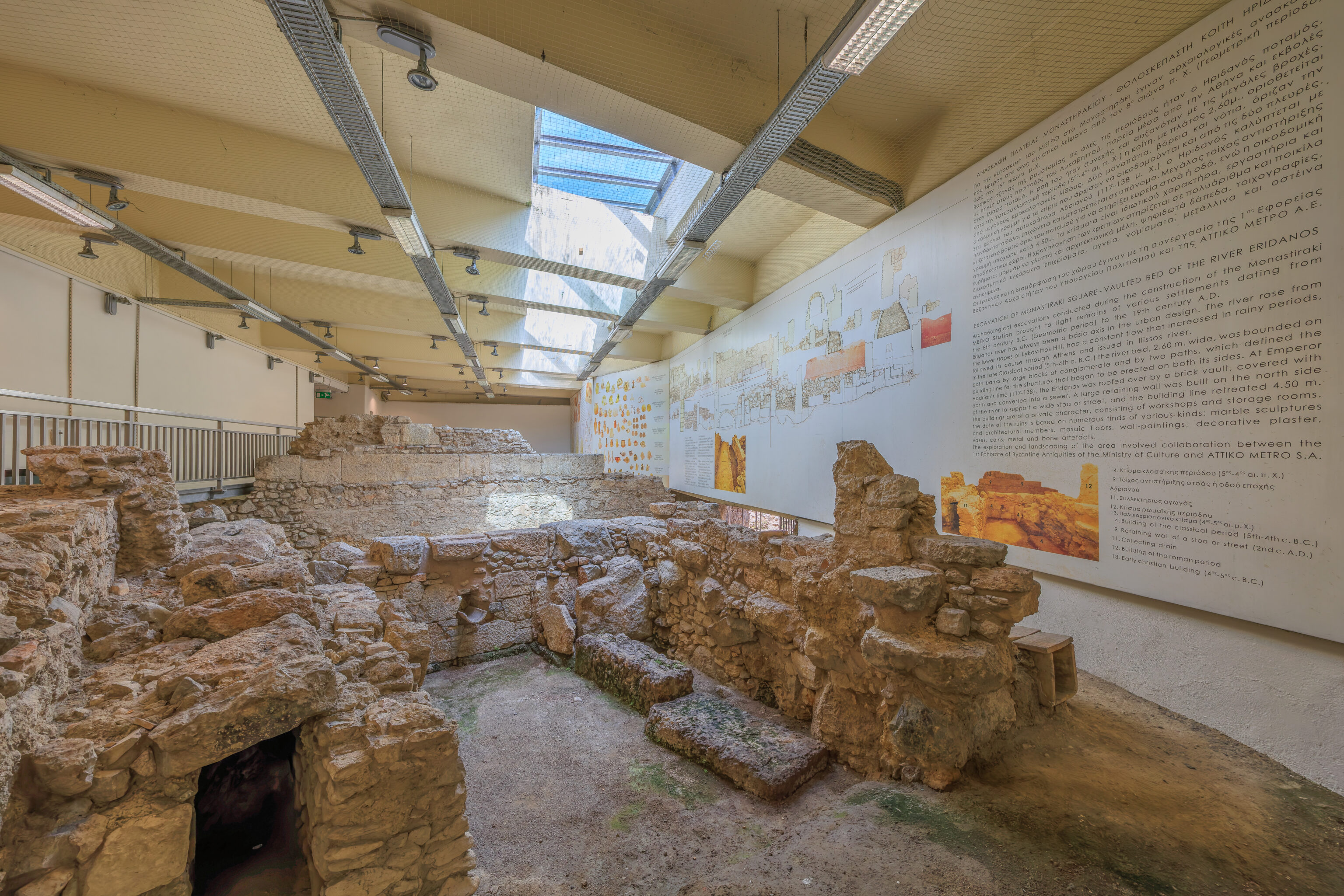
The Monastiraki Metro station actually has some preserved ruins.
The very large sign on the right explains what we see here:
EXCAVATION OF MONASTIRAKI SQUARE - VAULTED BED OF THE RIVER ERIDANOS
Archaeological excavations conducted during the construction of the Monastiraki METRO Station brought to light remains of various settlements dating from the 8th century B.C. (Geometric period) to the 19th century A.D. Eridanos river has always been a basic axis in the urban design. The river rose from the lower slopes of Lykavittos Hill, had a constant flow that increased in rainy periods, followed its course through Athens and issued in Ilissos river.
In the Late Classical period (5th-4th c. B.C.) the river bed, 2.60 m. wide, was bounded on both banks by large blocks of conglomerate and by two paths, which defined the building line for the structures that began to be erected on both its sides. At Emperor Hadrian's time (117-138), the Eridanos was roofed over by a brick vault, covered with earth and converted into a sewer. A large retaining wall was built on the north side of the river to support a wide stoa or street, and the building line retreated 4.50 m. The buildings are of a private character, consisting of workshops and storage rooms. The date of the ruins is based on numerous finds of various kinds: marble sculptures and architectural members, mosaic floors, wall-paintings, decorative plaster, vases, coins, metal and bone artefacts.
The exploration and landscaping of the area involved collaboration between the 1st Ephorate of Byzantine Antiquities of the Ministry of Culture and ATTIKO METRO S.A.
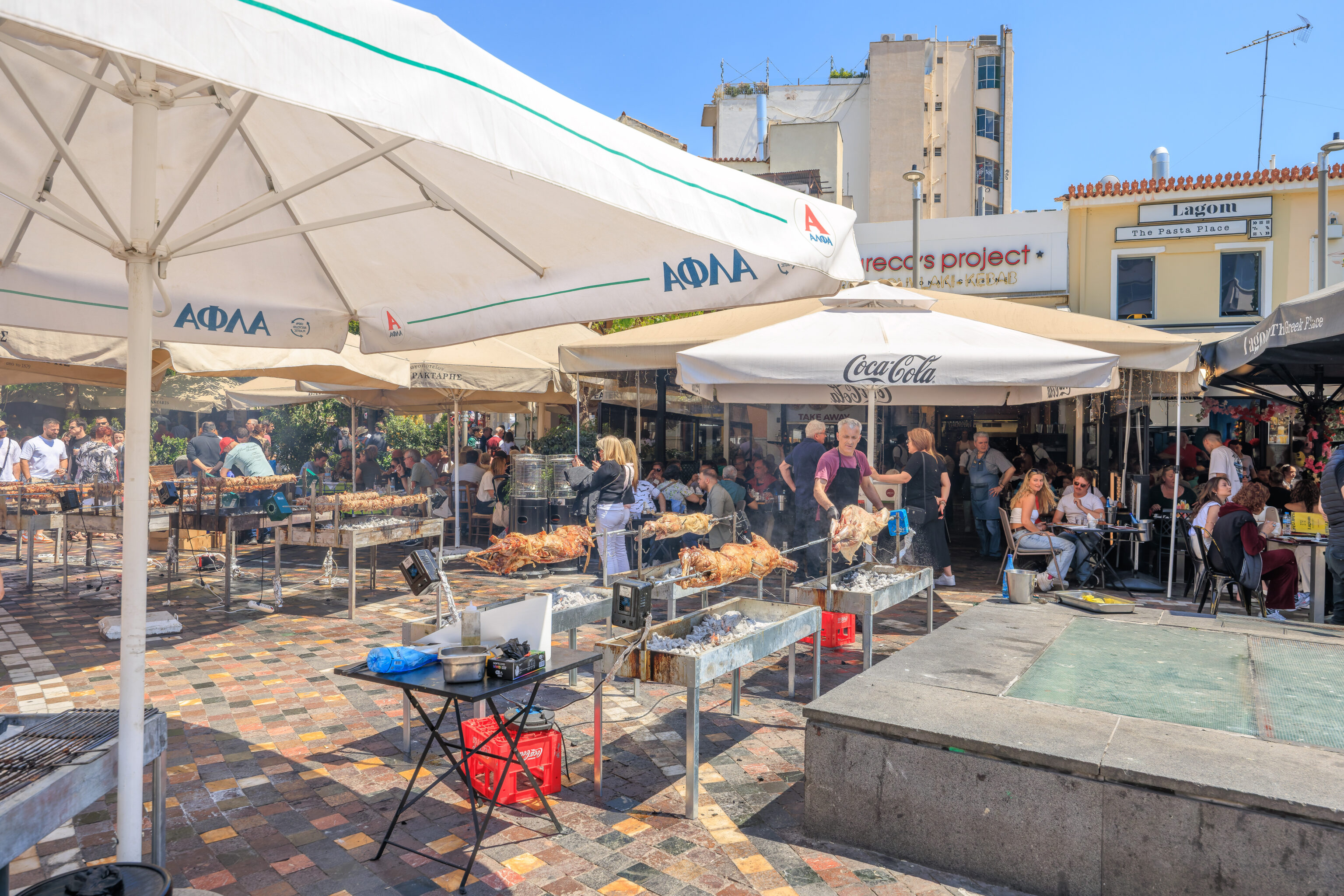
A traditional meal here in Greece on Easter is roasted lamb. Here at Monastiraki, we saw restaurants roasting lamb on spits outside. It looked very good! It was also ridiculously busy so we weren’t able to get a table at one of these restaurants.
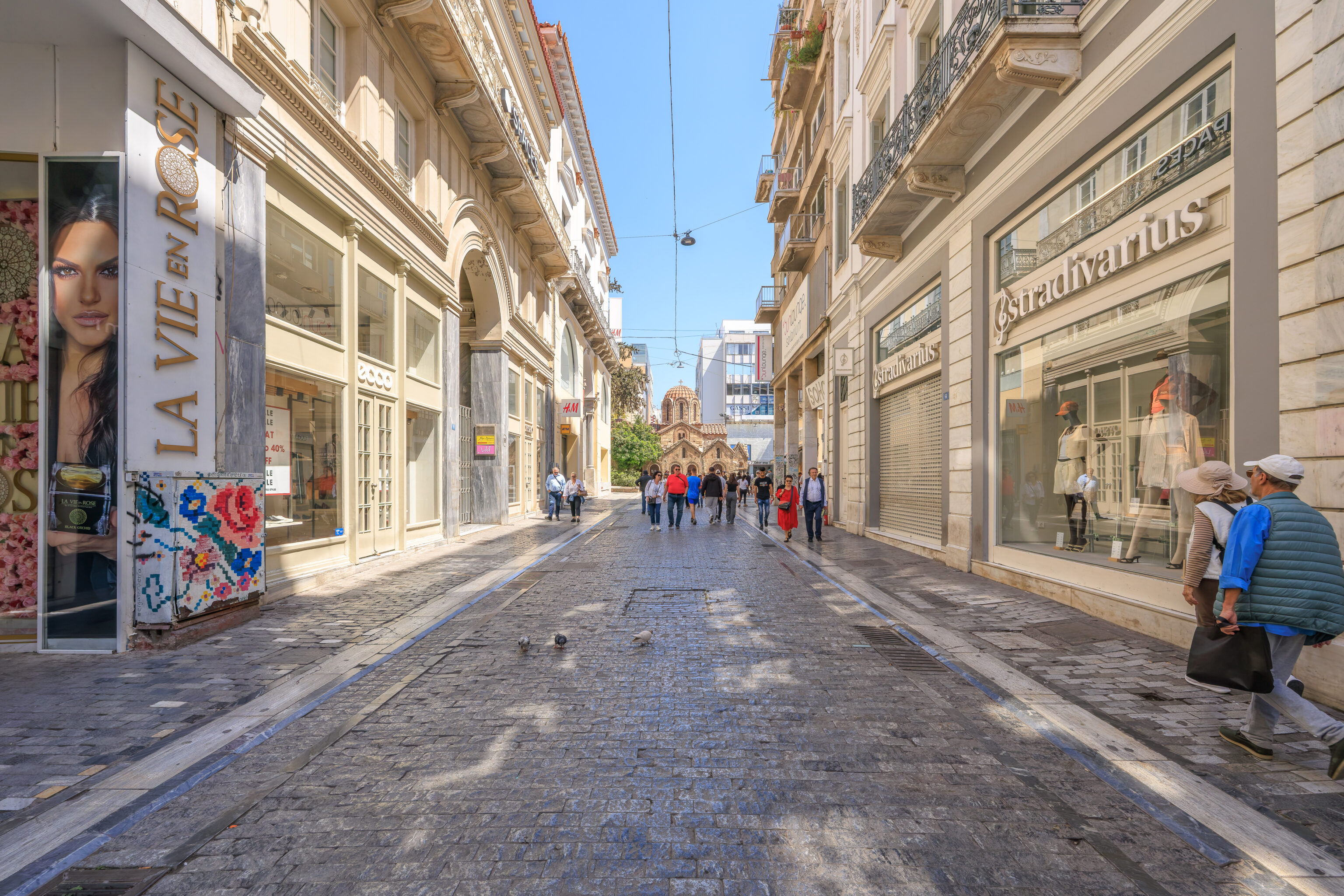
We ended up walking back towards Syntagma, looking for places to eat along the way. Pretty much everything was closed.
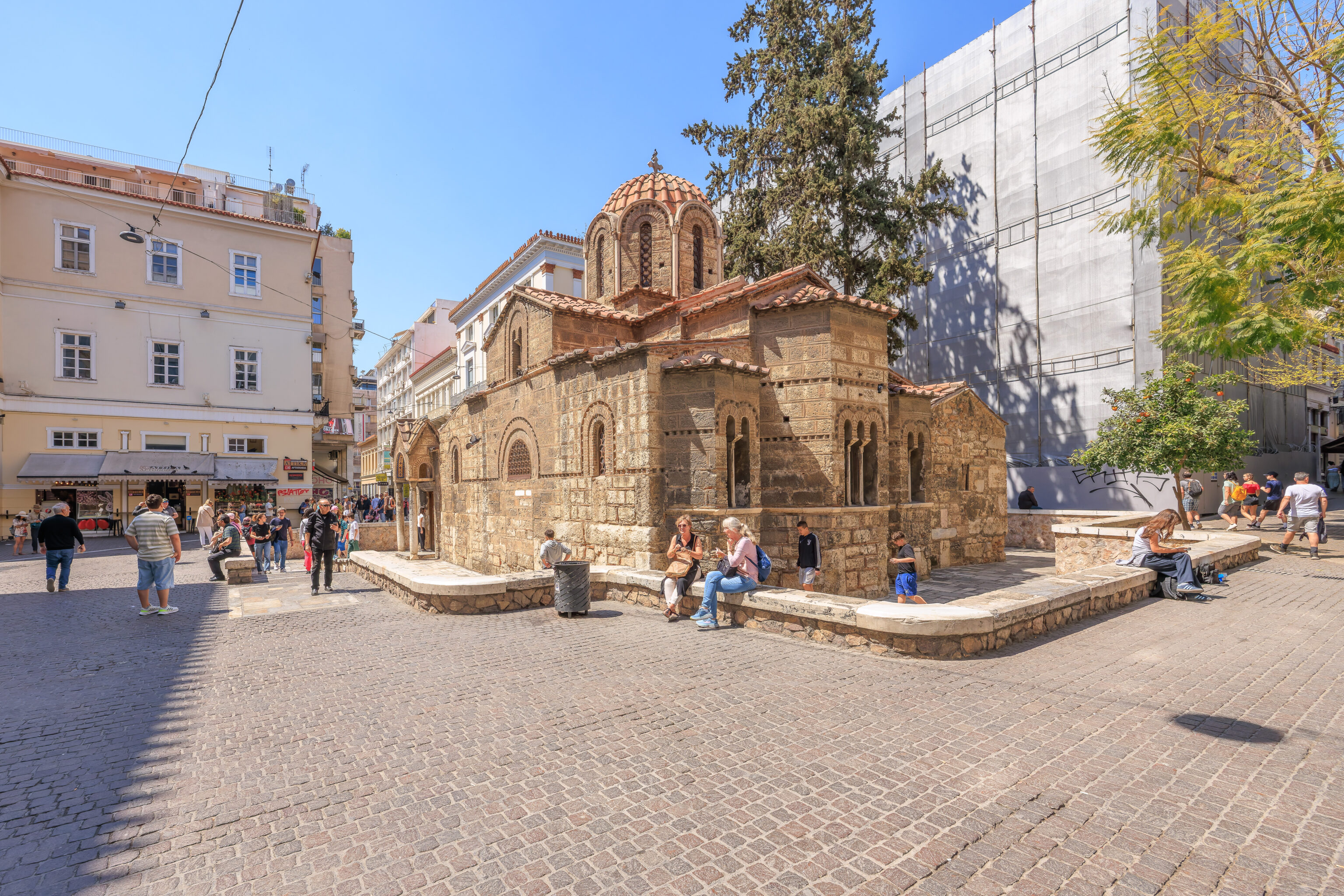
We walked by the small Church of Panagia Kapnikarea, which we’ve only seen from afar.

Syntagma was pretty dead when we arrived after finding nearly everything on the way from Monastiraki closed. But, we did find one place that was open and lively – The Greco’s Project! And, they were roasting lamb outside! Observant readers will notice that this is the same restaurant that we photographed in Monastiraki with the lamb spits out front. This location at Syntamga is the first of their three restaurants, all here in central Athens.
There was a queue outside but it wasn’t too long. So, we lined up and waited. We were seated inside at a nice location by the restaurant’s front window.

We decided to try Alfa beer, from Athens. It is made from 100% Greek barley according to their website.
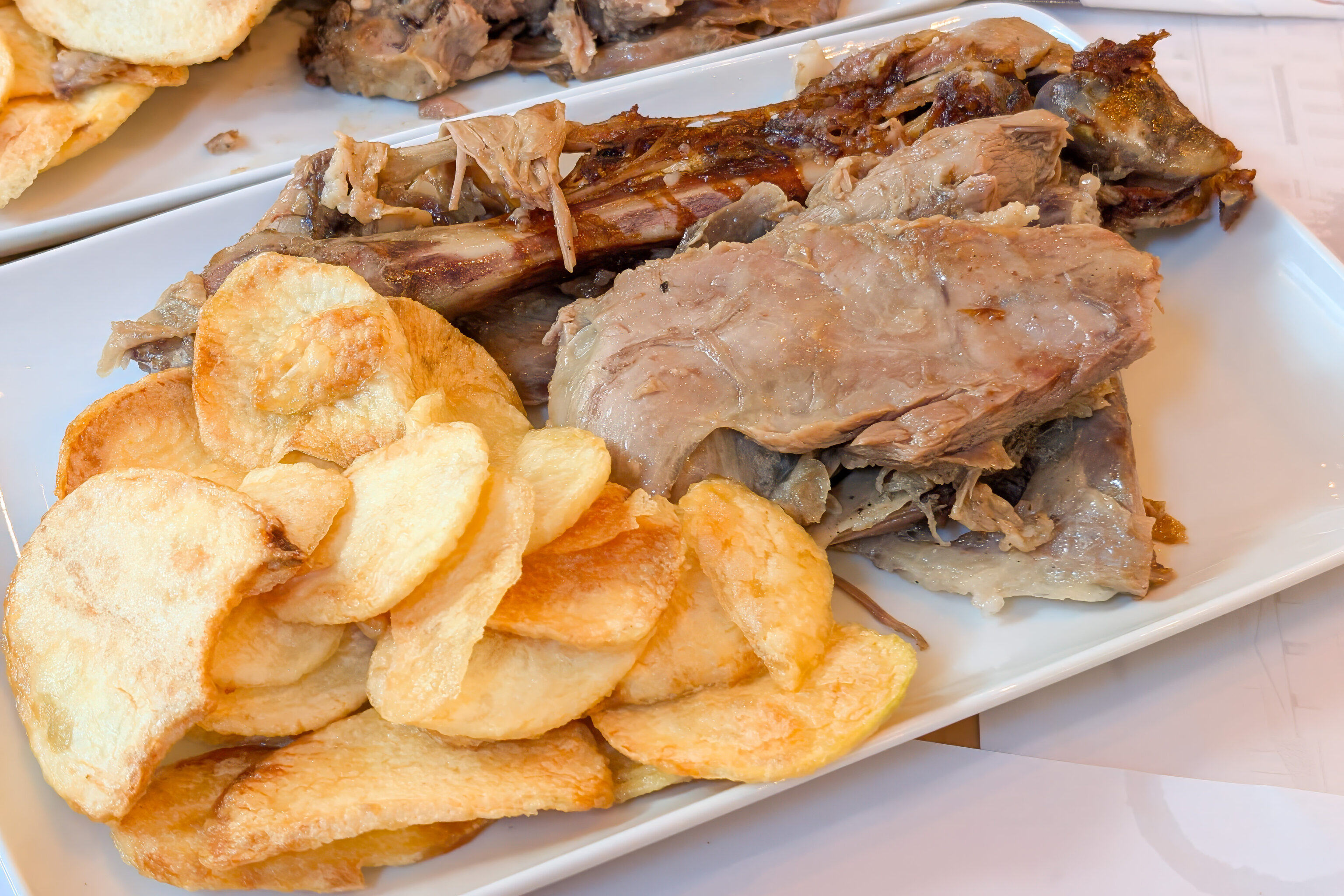
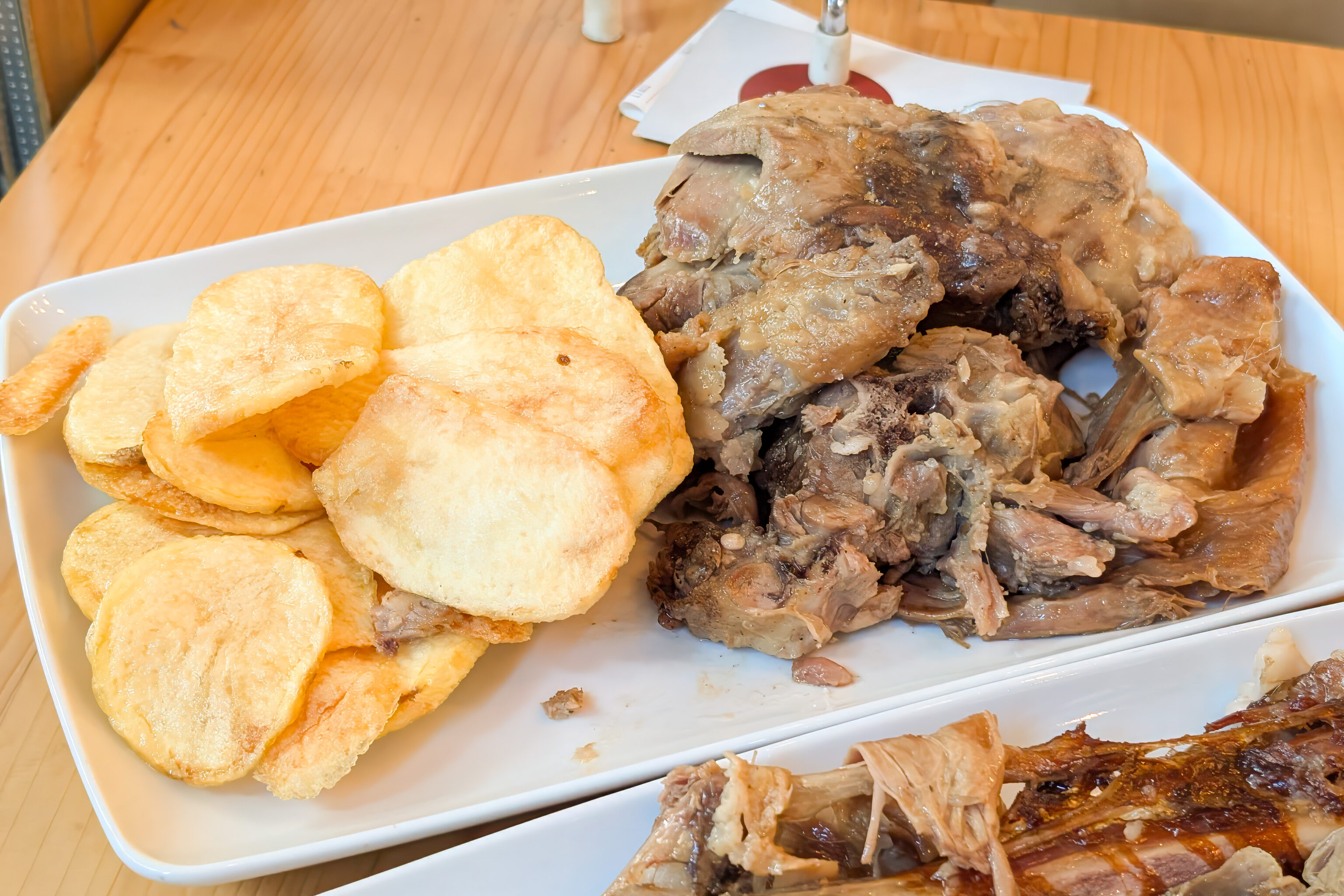
The Greco’s Project has a pretty extensive menu but we were here for one thing, the Easter roasted lamb! We placed two orders. It was a great meaty lunch!
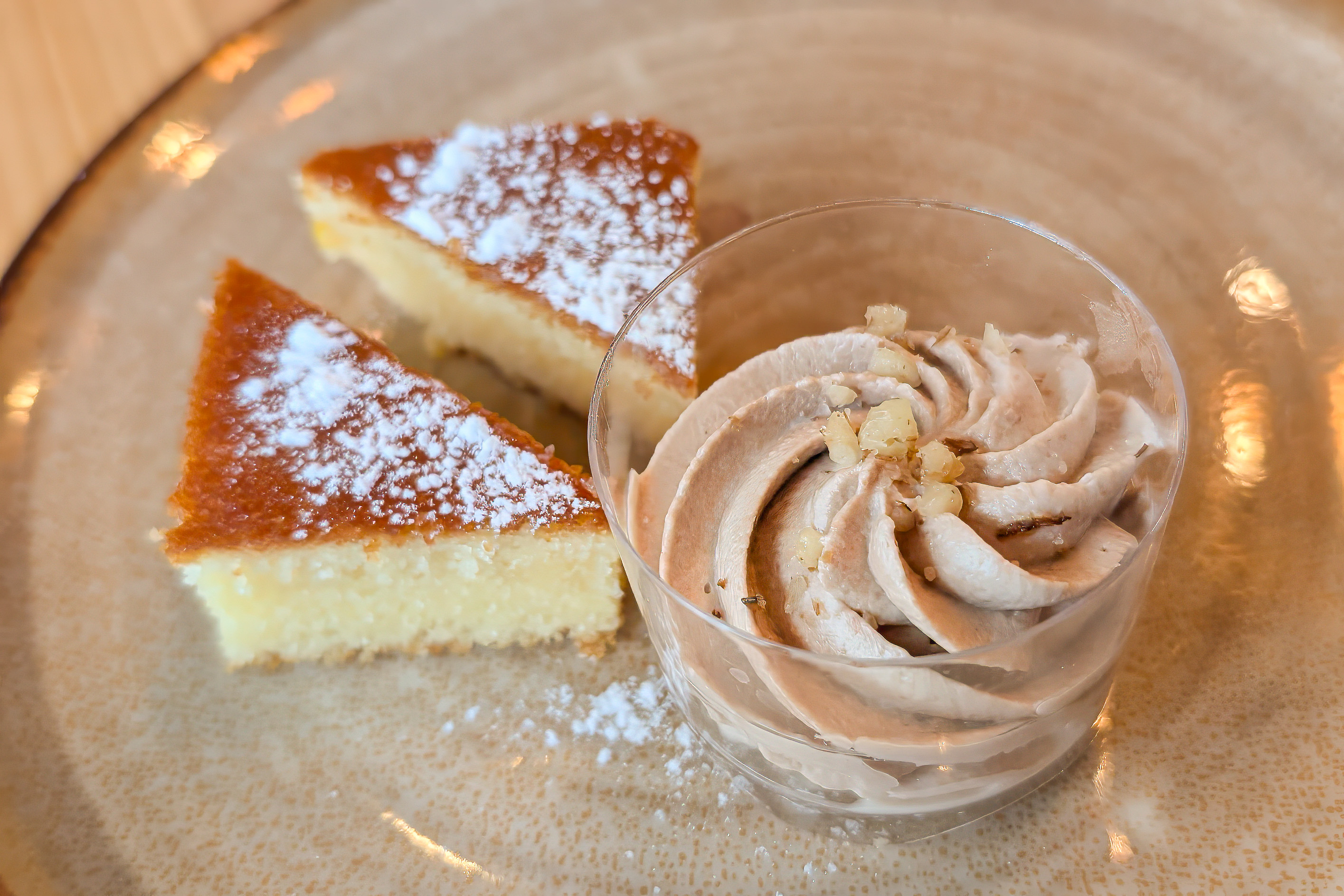
Complimentary dessert was also provided.
After dinner, we decided to walk over to Share Wish and Fun Joy for some bubble tea. We discovered the only Chinese owned businesses to actually close on a local holiday! Well, maybe they were Christian?
We were a bit disappointed that both were closed but at least we got to have Easter lamb today! We headed back to the Grande Bretagne to rest and digest.
- Leonidas S. Blaveris. On Friday, the old submarine “PROTEUS” will be towed to its place on land in Flisvos and will be open to the public. ThePressRoom. https://www.thepressroom.gr/amyna/tin-paraskeyi-tha-rymoylkithei-sti-thesi-toy-stin-xira-sto-floisbo-palaio-ypobryhio-proteys#goog_rewarded ↩︎
